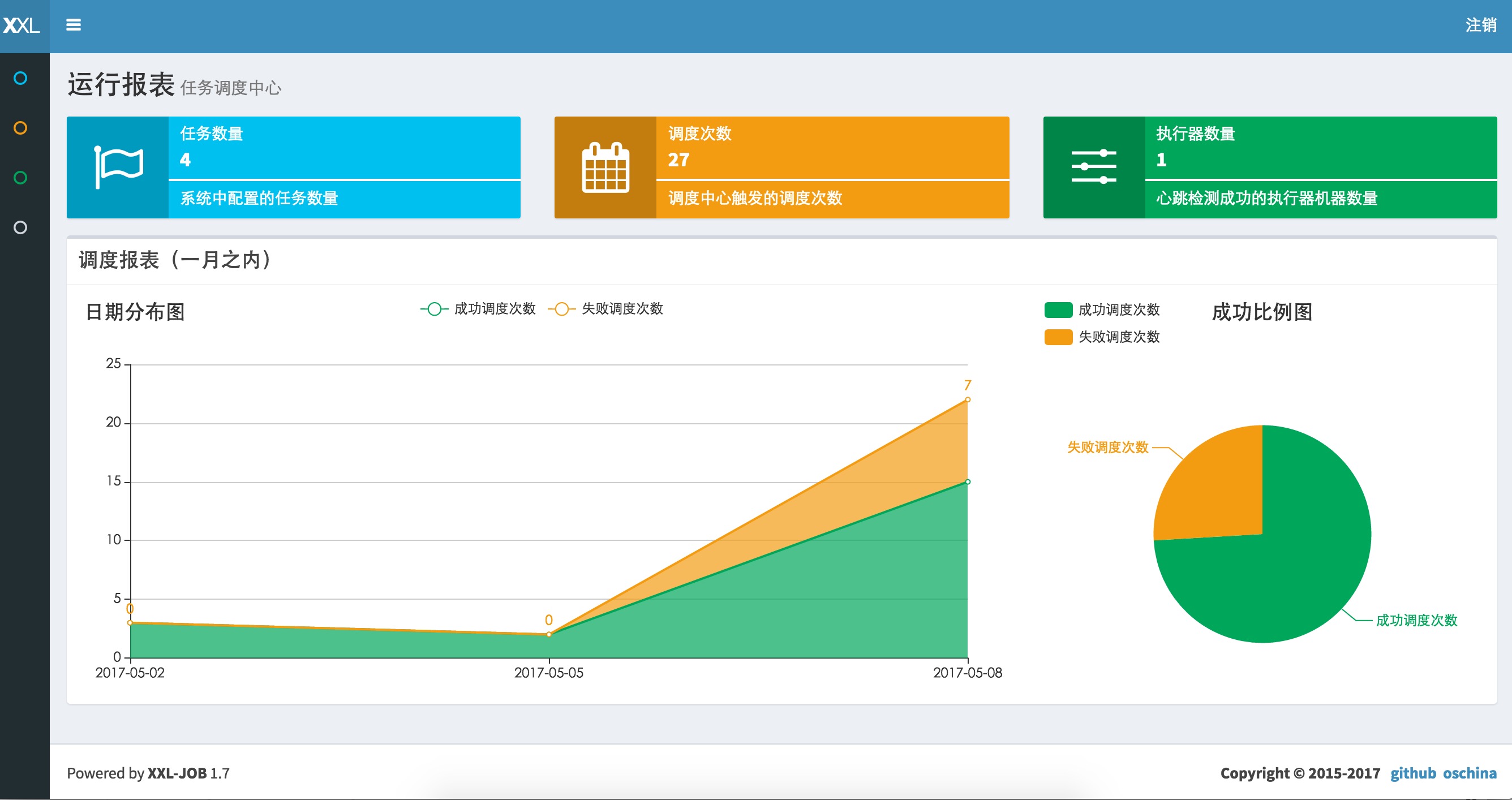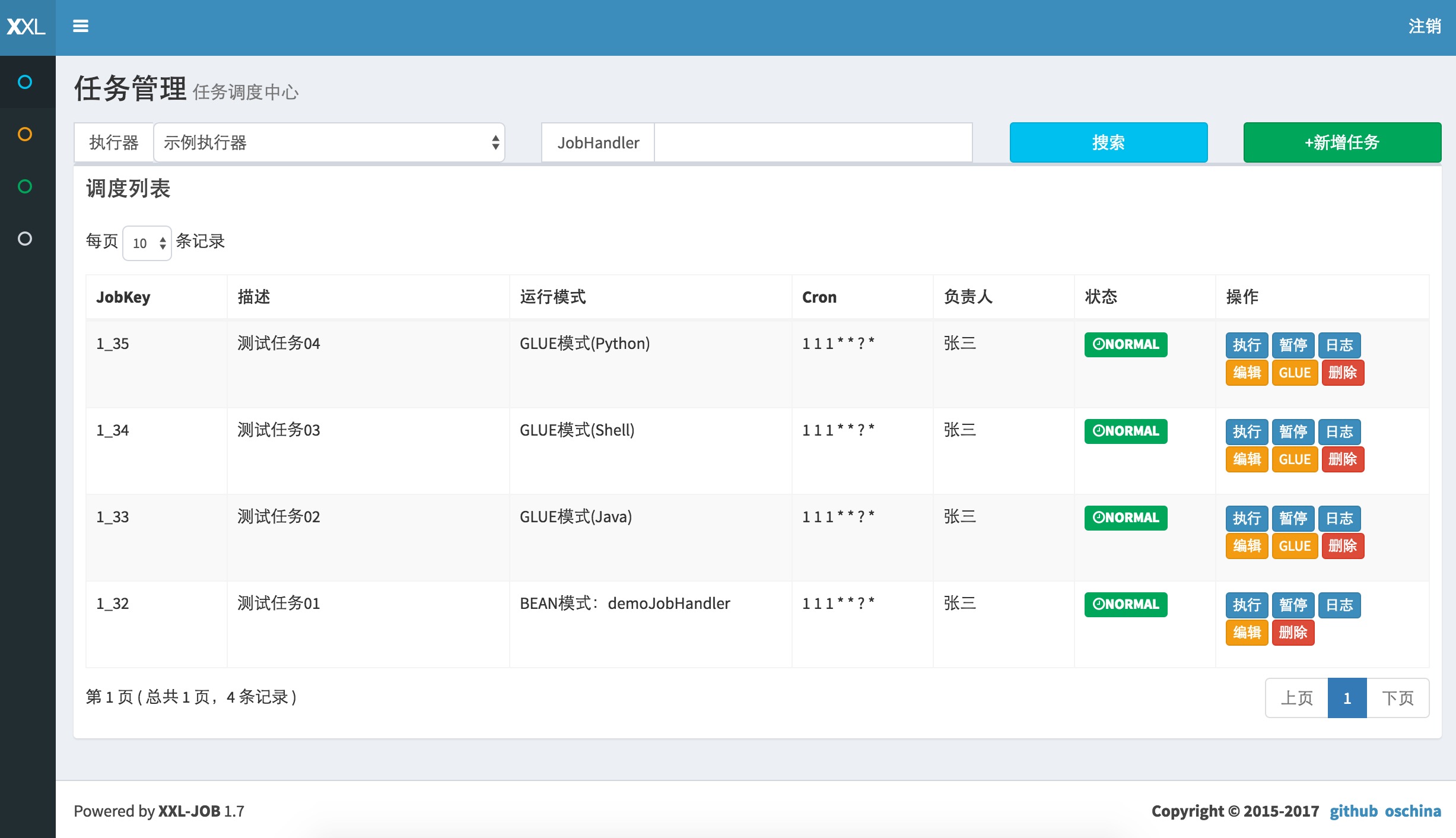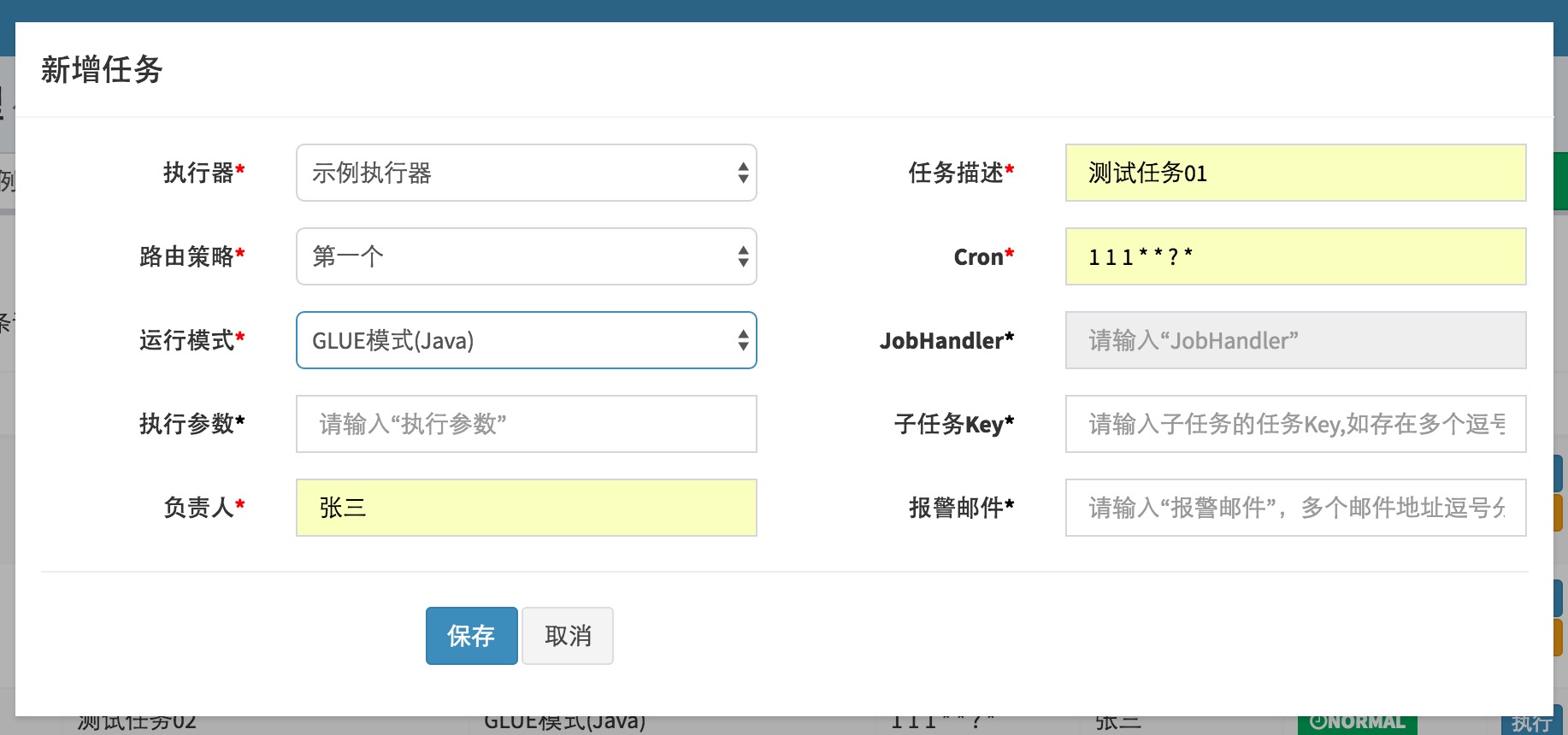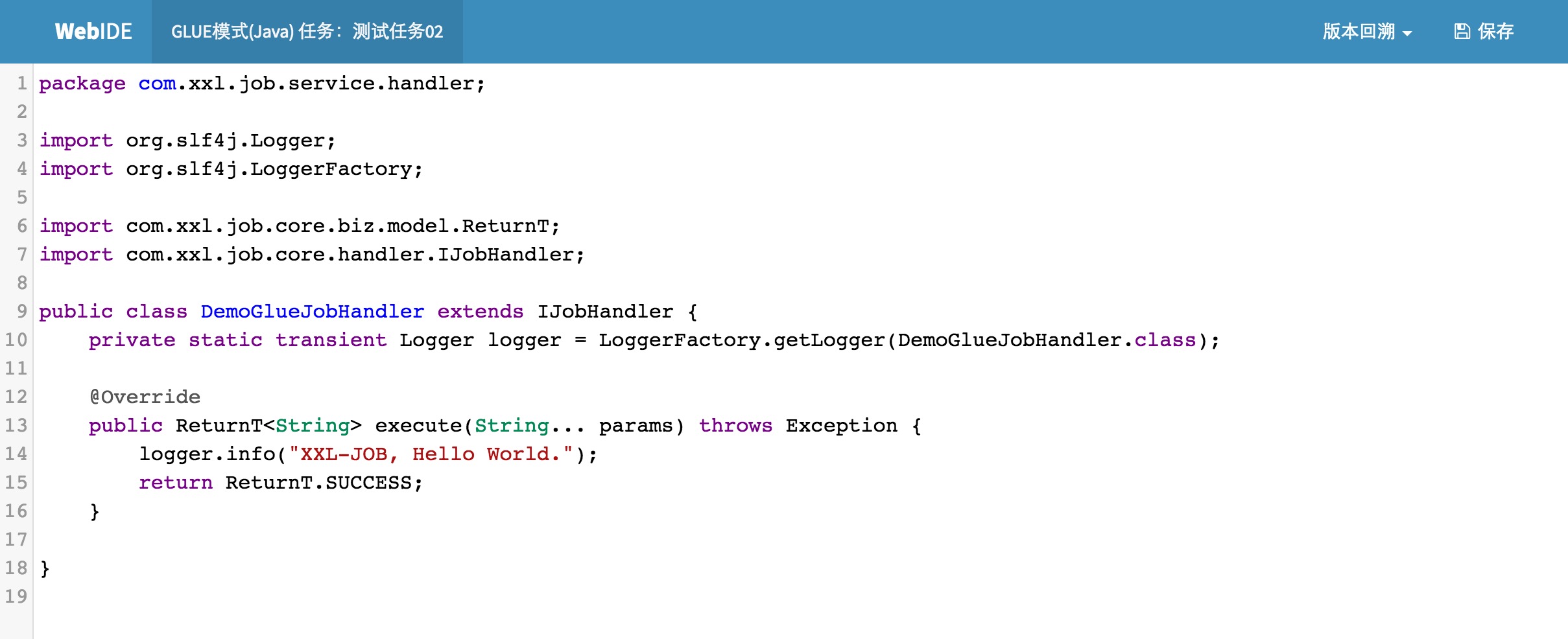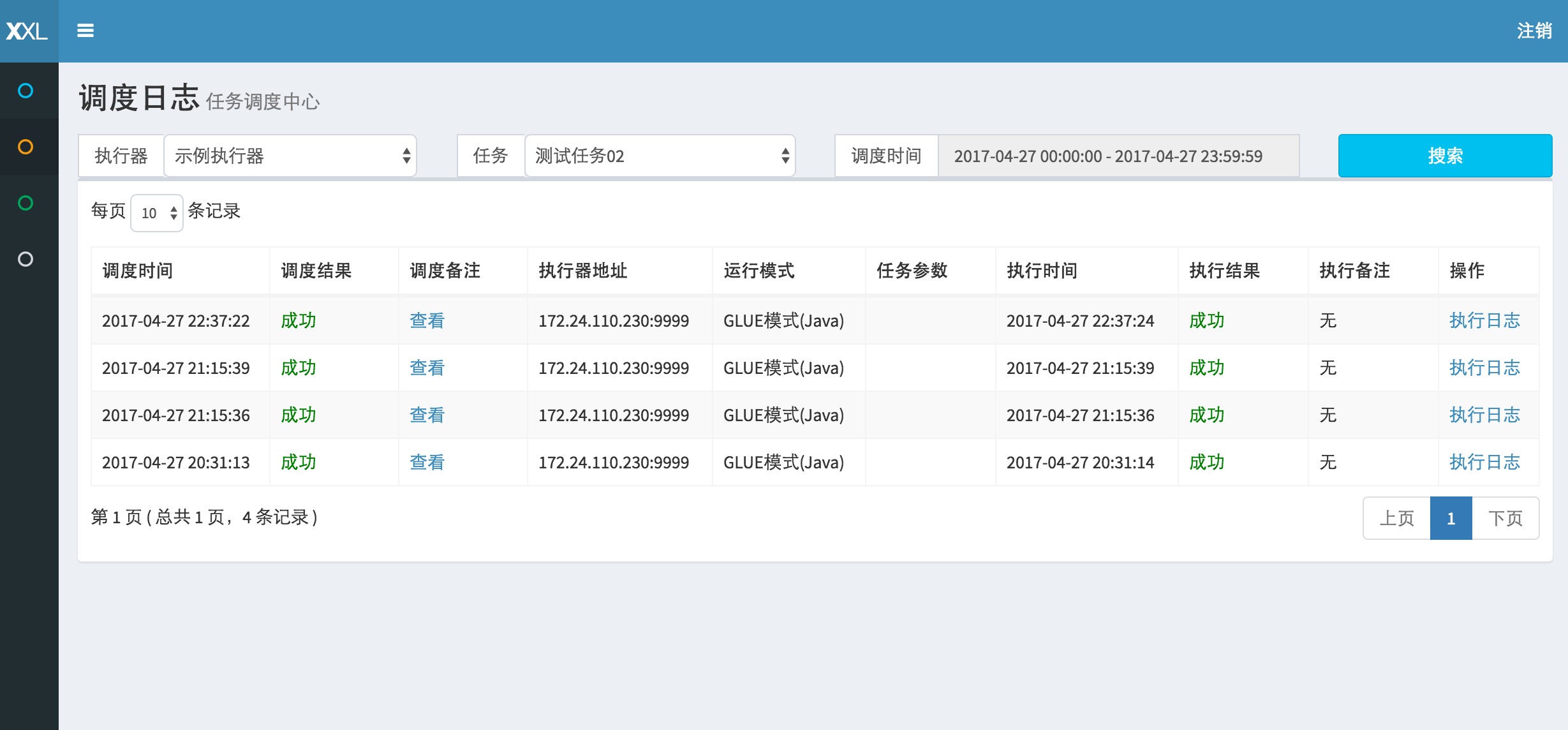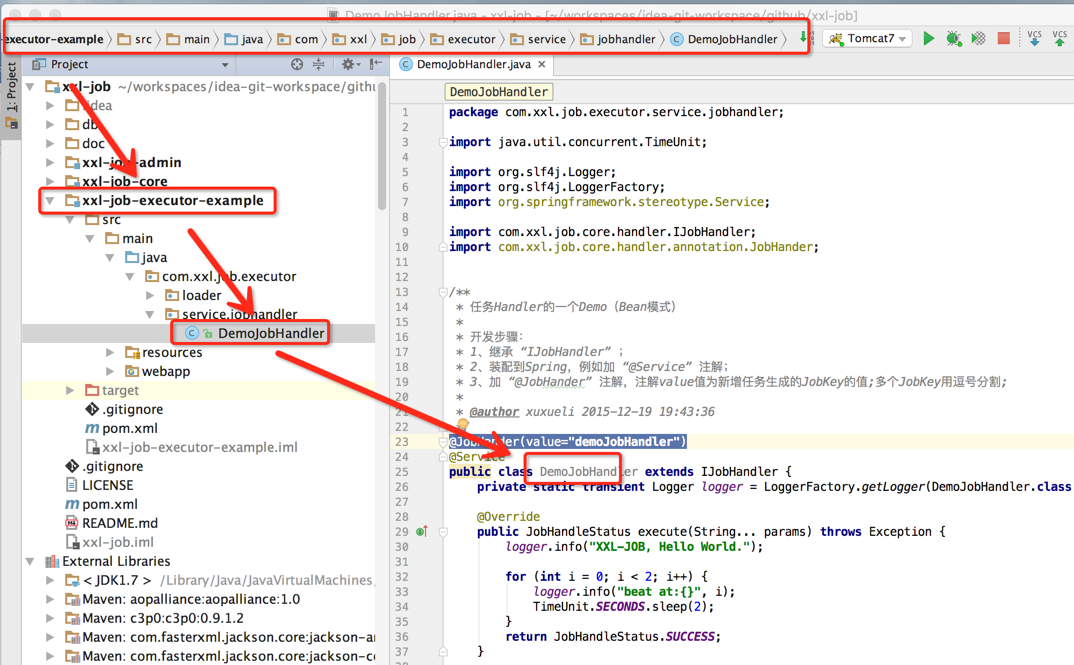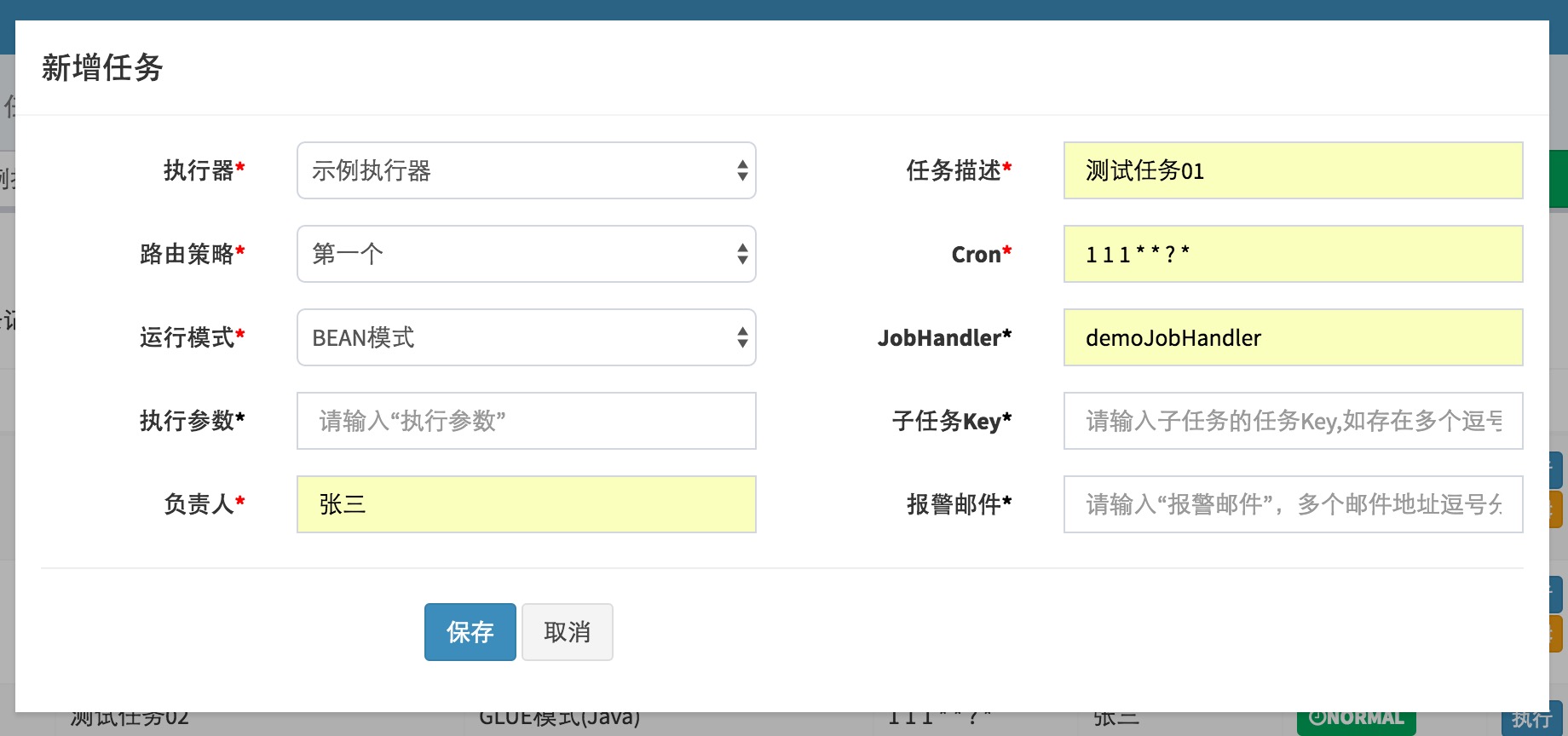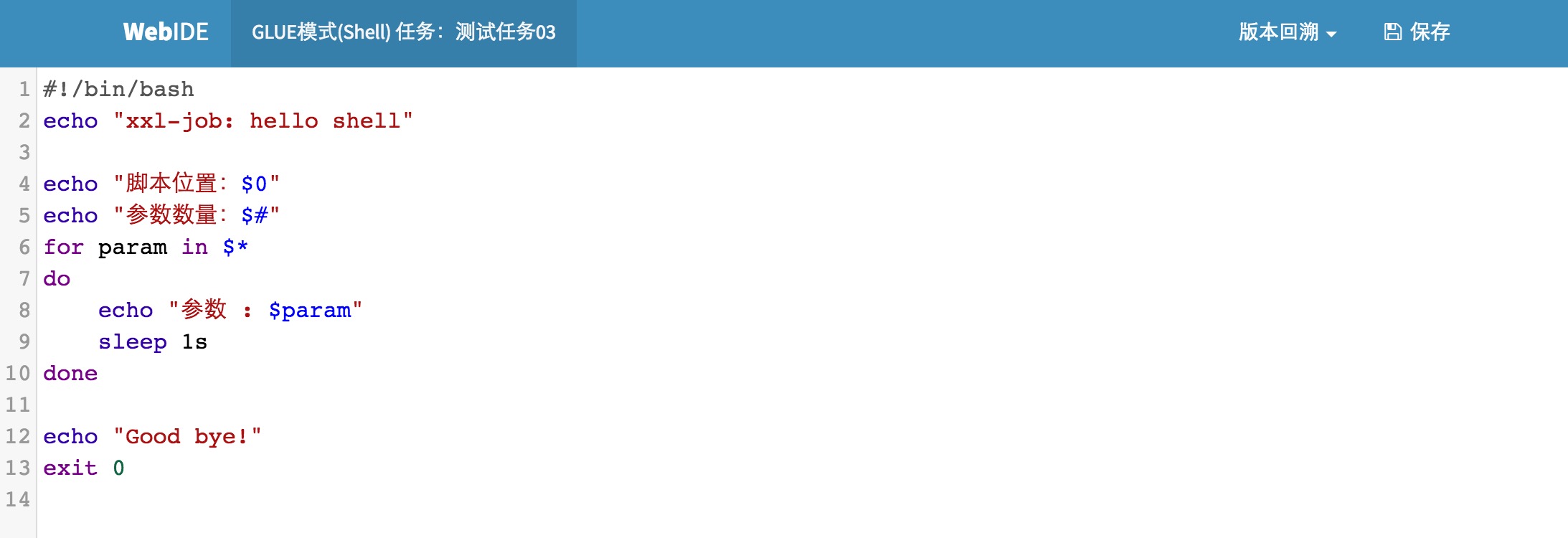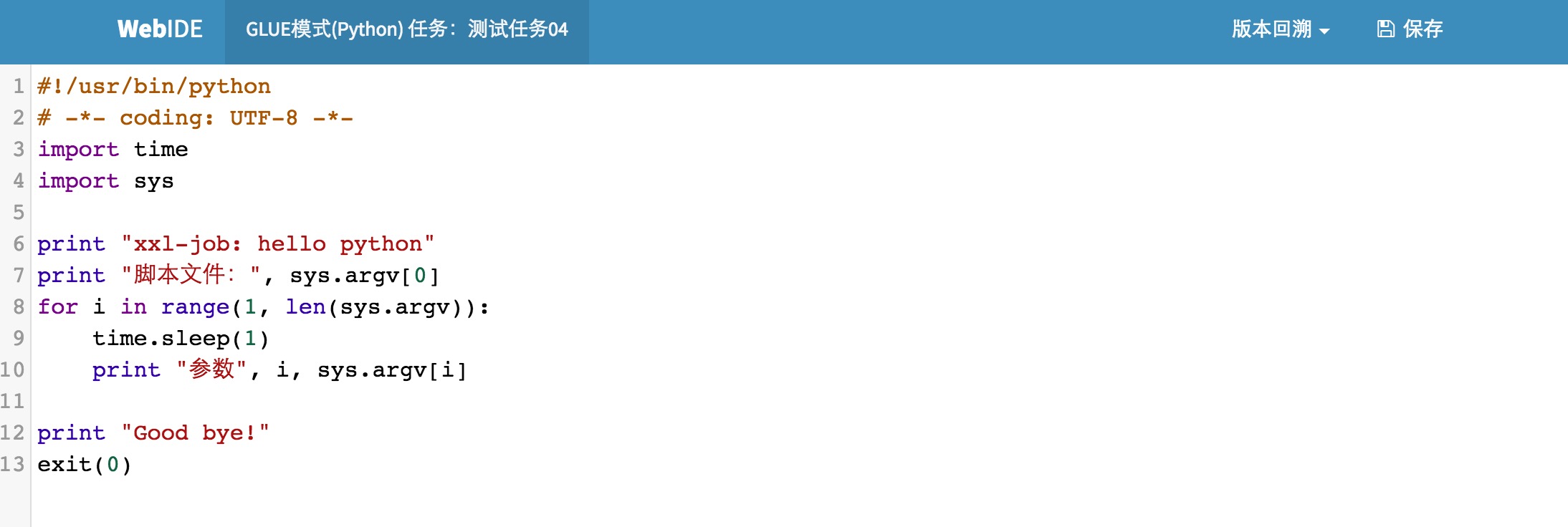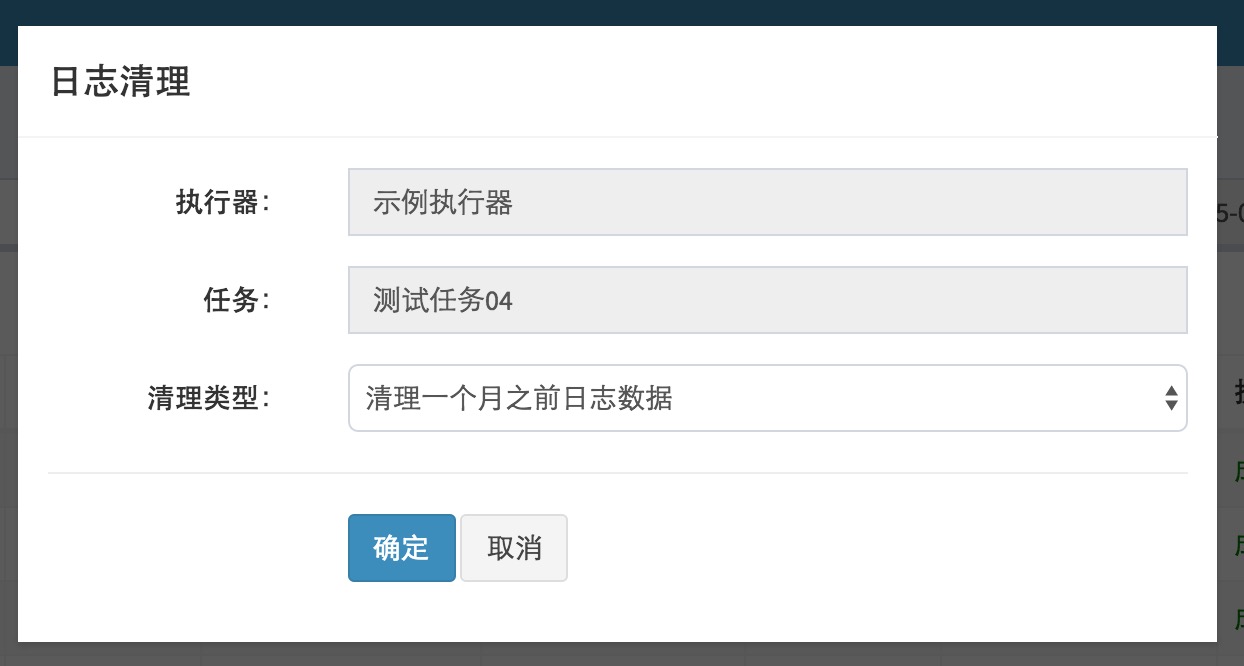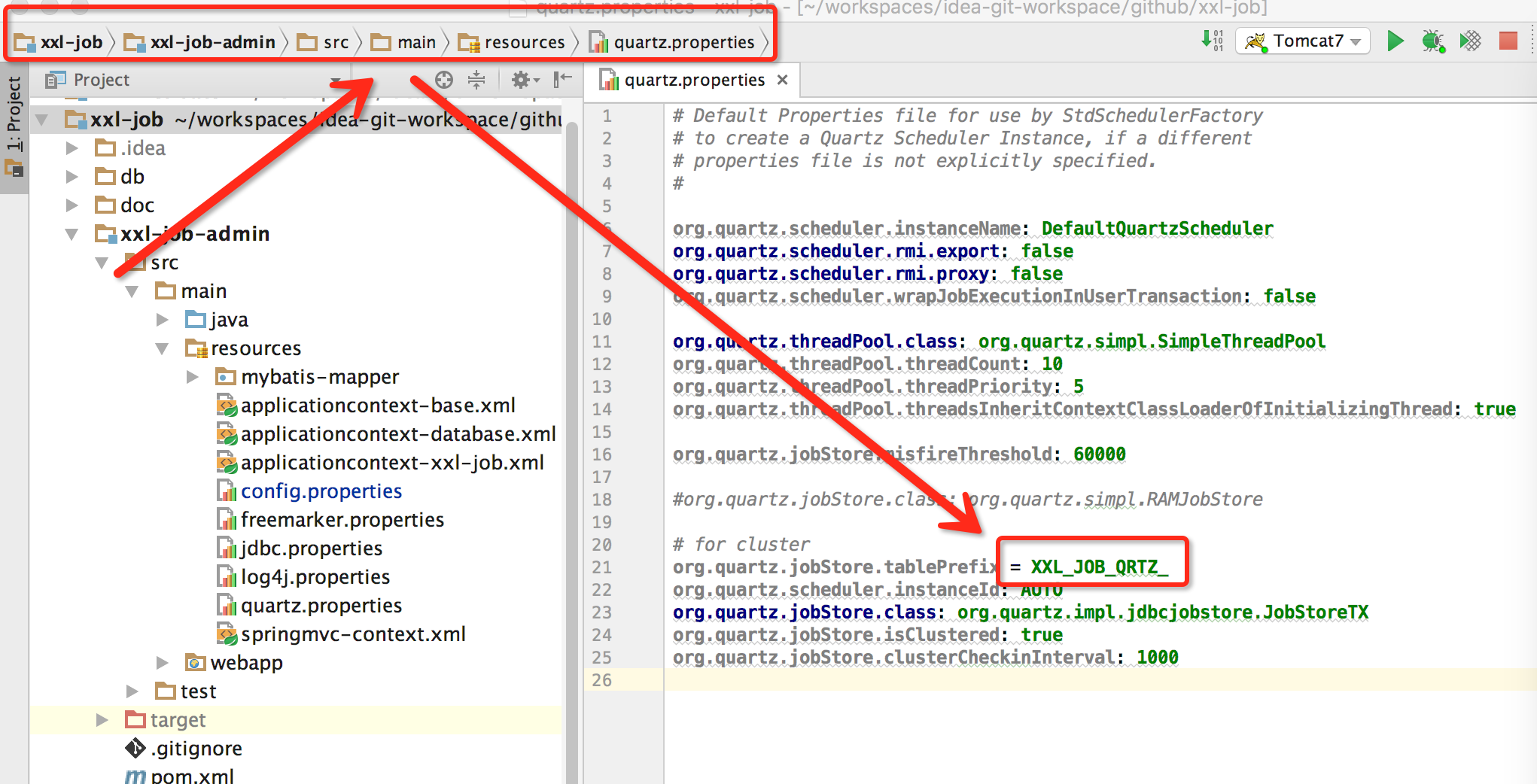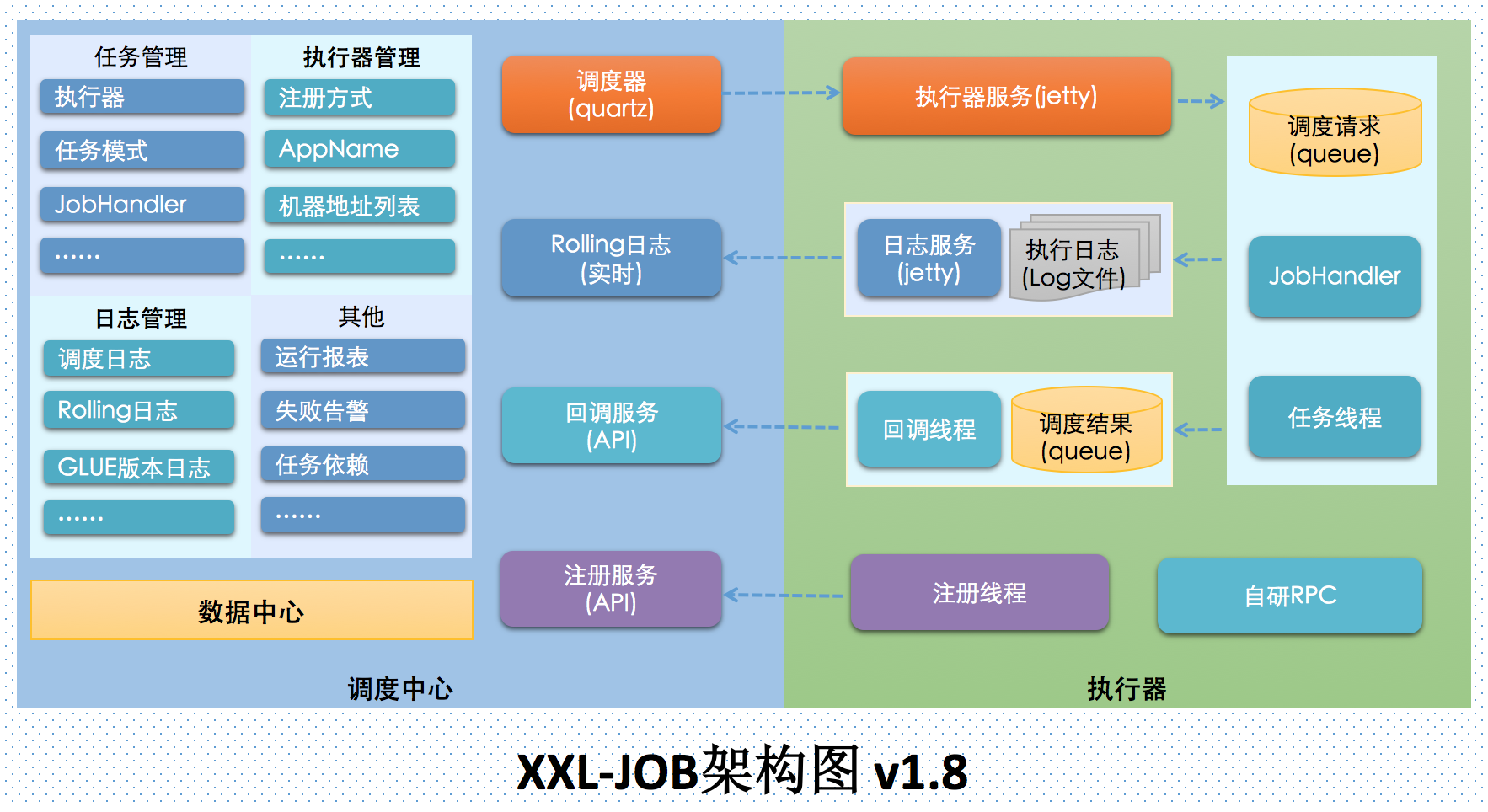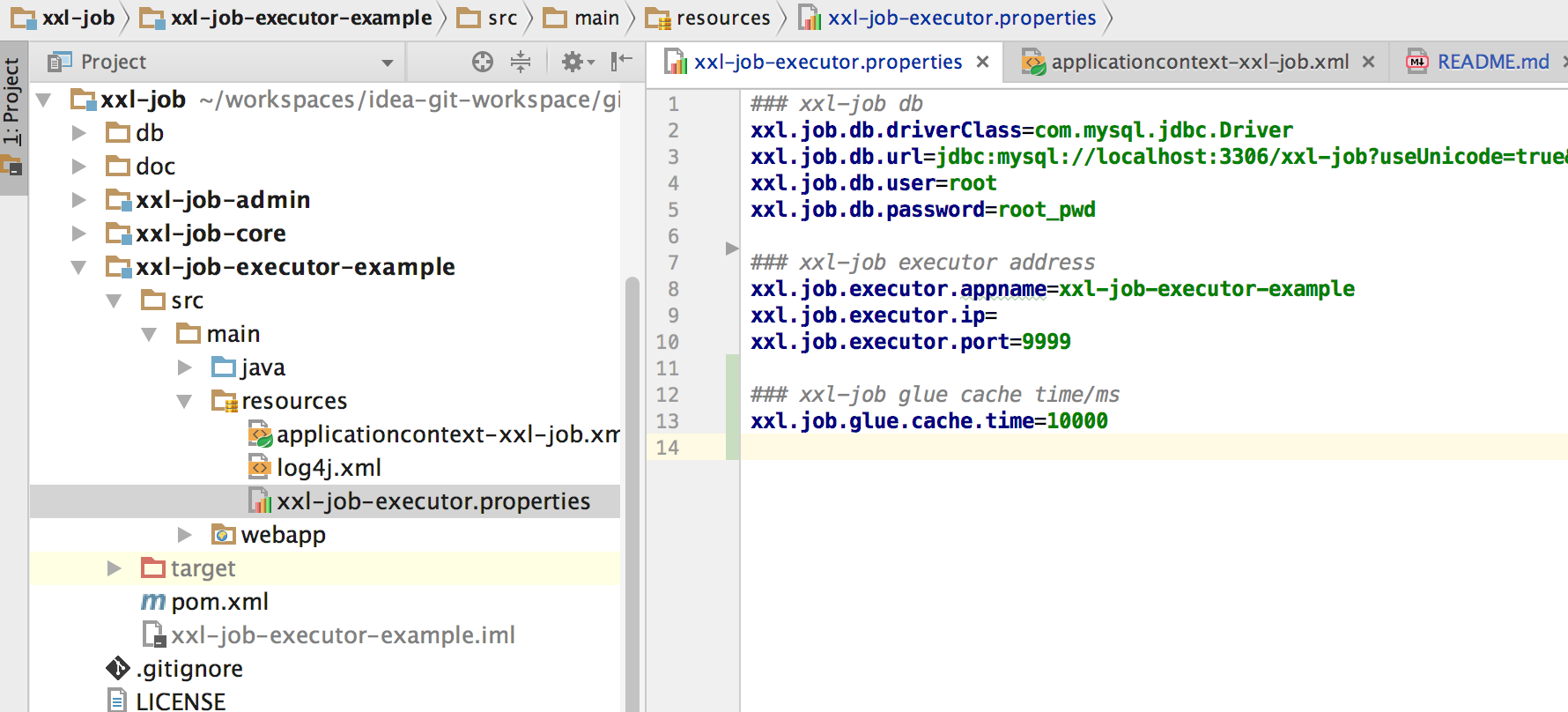XXL-JOB-English-Documentation.md 74 KB
„ÄäDistributed task scheduling framework XXL-JOB„Äč
1. Brief introduction
1.1 Overview
XXL-JOB is a lightweight distributed task scheduling framework, the core design goal is to develop quickly, learning simple, lightweight, easy to expand. Is now open source and access to a number of companies online product line, download and use it now.
1.2 Features
- 1.Simple: support through the Web page on the task CRUD operation, simple operation, a minute to get started;
- 2.Dynamic: support dynamic modification of task status, pause / resume tasks, and termination of running tasks,immediate effect;
- 3.Dispatch center HA (center type): Dispatch with central design, "dispatch center" based on the cluster of Quartz implementation, can guarantee the scheduling - center HA;
- 4.Executer HA (Distributed): Task Distributed Execution, Task " Executer " supports cluster deployment to ensure that tasks perform HA;
- 5.Task Failover: Deploy the Excuter cluster,tasks will be smooth to switch excuter when the strategy of the router choose ‚Äėfailover‚Äô;
- 6.Consistency: "Dispatch Center" through the DB lock to ensure the consistency of cluster distributed scheduling,one task excuted for once;
- 7.Custom task parameters: support online configuration scheduling tasks into the parameters, immediate effect;
- 8.Scheduling thread pool: scheduling system multi-threaded trigger scheduling operation, to ensure accurate scheduling, not blocked;
- 9.Elastic expansion capacity: once the new executor machine on the line or off the assembly line, the next time scheduling will be re-assigned tasks;
- 10.Mail alarm: the task fails to support e-mail alarm, support configuring multiple email addresses to send bulk alert messages;
- 11.Status monitoring: support real-time monitoring of the progress of the task;
- 12.Rolling execution log: support online view scheduling results, and support Rolling real-time view of the executer output of the complete implementation of the log;
- 13.GLUE: provide Web IDE, support online development task logic code, dynamic release, real-time compiler effective, omit the deployment of the on-line process. Supports historical versions of 30 versions back;
- 14.Data Encryption: The communication between the dispatching center and the executor is used for data encryption, Enhancing the security of dispatching information;
- 15.Task Dependency: Support configuration subtask dependencies, When the parent task executed end and after the success of the implementation will take the initiative to trigger a second task execution, multiple sub tasks are separated by commas;
- 16.Push the Maven central warehouse: The latest stable version will be sent to the Maven central warehouse to facilitate user access and use;
- 17.Task registration: The executor automatically registers tasks periodically, and the dispatch center automatically finds the registered tasks and triggers execution. It also supports manual input of executor address;
- 18.Router strategy: A rich routing strategy is provided when the executor cluster is deployed, these include: first, last, poll, random, consistent HASH, least frequently used, least recently used, failover, busy over, sharding broadcast,etc.;
- 19.Report monitor: Support real-time view of running data, such as the number of tasks, the number of dispatch, the number of executors, etc .; and scheduling reports, such as scheduling date distribution, scheduling success map;
- 20.Script task: Support the development and operation of script tasks in GLUE mode, including shell, Python and other types of script;
- 21.Blocking handling strategy: The scheduling is too dense and the executor is too late to handle. The strategy includes: single machine serial (default), discarding the following scheduling, and Override the previous scheduling;
- 22.Failure handling strategy:Handling strategy when scheduling fails, the strategy includes: failure alarm (default), failure retry;
- 23.Sharding broadcast task: When an executor cluster is deployed, task routing strategy select "sharding broadcast", a task schedule will broadcast all the actuators in the cluster to perform it once, you can develop sharding tasks based on sharding parameters;
- 24.Dynamic sharding: The sharding broadcast task is sharded by the executors to support the dynamic expansion of the executor cluster to dynamically increase the number of shardings and cooperate with the business handle; In the large amount of data operations can significantly improve the task processing capacity and speed.
- 25„ÄĀEvent triggerÔľöIn addition to "Cron" and "Task Dependency" to trigger tasks, support event-based triggering tasks. The dispatch center provides API service that triggers a single execution of the task, it can be triggered flexibly according to business events.
1.3 Development
In 2015, I created the XXL-JOB project repository on github and submitted the first commit, followed by the system structure design, UI selection, interactive design ... In 2015 - November, XXL-JOB finally RELEASE the first big version of V1.0, then I will be released to OSCHINA, XXL-JOB OSCHINA won the popular recommendation of @ÁļĘŤĖĮ, the same period reached OSCHINA's " Popular move "ranked first and git.oschina open source software monthly heat ranked first, especially thanks for @ÁļĘŤĖĮ, thank you for the attention and support. In 2015 - December, I will XXL-JOB published to our internal knowledge base, and get internal colleagues recognized. In 2016 - 01 months, my company started XXL-JOB internal access and custom work, in this thank Yuan and Yin two colleagues contribution, but also to thank the internal other attention and support colleagues. In 2017-05-13, the link of "let the code run" in "the 62nd source of open source China Genesis" held in Shanghai,, I stepped on and made a speech about the XXL-JOB, five hundred spectators in the audience reacted enthusiastically (pictorial review).
Our company have access to XXL-JOB, internal alias "Ferrari" (Ferrari based on XXL-JOB V1.1 version customization, new access application recommended to upgrade the latest version). According to the latest statistics, from 2016-01-21 to 2017-07-07 period, the system has been scheduled about 600,000 times, outstanding performance. New access applications recommend the latest version, because after several major updates, the system's task model, UI interaction model and the underlying scheduling communication model has a greater optimization and upgrading, the core function more stable and efficient.
So far, XXL-JOB has access to a number of companies online product line, access to scenes such as electronic commerce, O2O business and large data operations, as of 2016-07-19, XXL-JOB has access to the company But not limited to:
- 1„ÄĀŚ§ßšľóÁāĻŤĮĄÔľõ
- 2„ÄĀŚĪĪšłúŚ≠¶ŤÄĆÁĹĎÁĽúÁßĎśäÄśúČťôźŚÖ¨ŚŹłÔľõ
- 3„ÄĀŚģČŚĺĹśÖßťÄöšļíŤĀĒÁßĎśäÄśúČťôźŚÖ¨ŚŹłÔľõ
- 4„ÄĀšļļšļļŤĀöŤīĘťáĎśúćÔľõ
- 5„ÄĀšłäśĶ∑ś£†ś££šŅ°śĀĮÁßĎśäÄŤā°šĽĹśúČťôźŚÖ¨ŚŹł
- 6„ÄĀŤŅźśĽ°śĽ°
- 7„ÄĀÁĪ≥ŚÖ∂śěó (šł≠ŚõĹŚĆļ)
- 8„ÄĀŚ¶ąŚ¶ąŤĀĒÁõü
- 9„ÄĀšĻĚś®ĪŚ§©šłčÔľąŚĆóšļ¨ÔľČšŅ°śĀĮśäÄśúĮśúČťôźŚÖ¨ŚŹł
- 10„ÄĀšłáśôģśčČśĖĮÁßĎśäÄśúČťôźŚÖ¨ŚŹł(šłÄŚä†śČčśúļ)
- 11„ÄĀšłäśĶ∑šļŅšŅĚŚĀ•Śļ∑Áģ°ÁźÜśúČťôźŚÖ¨ŚŹł
- 12„ÄĀśĶ∑ŚįĒť¶®Śé® (śĶ∑ŚįĒ)
- 13„ÄĀś≤≥ŚćóŚ§ßÁļĘŚĆÖÁĒĶŚ≠źŚēÜŚä°śúČťôźŚÖ¨ŚŹł
- 14„ÄĀśąźťÉĹť°ļÁāĻÁßĎśäÄśúČťôźŚÖ¨ŚŹł
- 15„ÄĀś∑ĪŚú≥ŚłāśÄ°šļöťÄö
- 16„ÄĀś∑ĪŚú≥ťļ¶šļöšŅ°ÁßĎśäÄŤā°šĽĹśúČťôźŚÖ¨ŚŹł
- 17„ÄĀšłäśĶ∑ŚćöŤéĻÁßĎśäÄšŅ°śĀĮśäÄśúĮśúČťôźŚÖ¨ŚŹł
- 18„ÄĀšł≠ŚõĹŚĻ≥ŚģČÁßĎśäÄśúČťôźŚÖ¨ŚŹł
- 19„ÄĀśĚ≠Ś∑ěÁü•śó∂šŅ°śĀĮÁßĎśäÄśúČťôźŚÖ¨ŚŹł
- 20„ÄĀŚćöŤéĻÁßĎśäÄÔľąšłäśĶ∑ԾȜúČťôźŚÖ¨ŚŹł
- 21„ÄĀśąźťÉĹšĺĚŤÉĹŤā°šĽĹśúČťôźŤī£šĽĽŚÖ¨ŚŹł
- 22„ÄĀśĻĖŚćóťęėťė≥ťÄöŤĀĒšŅ°śĀĮśäÄśúĮśúČťôźŚÖ¨ŚŹł
- 23„ÄĀś∑ĪŚú≥Śłāťā¶Śĺ∑śĖáŚĆĖŚŹĎŚĪēśúČťôźŚÖ¨ŚŹł
- 24„ÄĀÁ¶ŹŚĽļťėŅśÄĚŚŹĮÁĹĎÁĽúśēôŤā≤śúČťôźŚÖ¨ŚŹł
- 25„ÄĀšľėšŅ°šļĆśČčŤĹ¶
- 26„ÄĀšłäśĶ∑śā†śłłŚ†āśäēŤĶĄŚŹĎŚĪēŤā°šĽĹśúČťôźŚÖ¨ŚŹł
- 27„ÄĀŚĆóšļ¨Á≤ČÁ¨ĒŤďĚŚ§©ÁßĎśäÄśúČťôźŚÖ¨ŚŹł
- 28„ÄĀšł≠ÁßÄÁßĎśäÄ(śó†ťĒ°)śúČťôźŚÖ¨ŚŹł
- 29„ÄĀś≠¶śĪČÁ©ļŚŅÉÁßĎśäÄśúČťôźŚÖ¨ŚŹł
- 30„ÄĀŚĆóšļ¨ŤöāŤöĀť£éśöīÁßĎśäÄśúČťôźŚÖ¨ŚŹł
- 31„ÄĀŚõõŚ∑ĚšļíŚģúŤĺĺÁßĎśäÄśúČťôźŚÖ¨ŚŹł
- 32„ÄĀťíĪŚĆÖŤ°ĆšļĎÔľąŚĆóšļ¨ÔľČÁßĎśäÄśúČťôźŚÖ¨ŚŹł
- 33„ÄĀťáćŚļÜś¨£śČćťõÜŚõĘ
- 34„ÄĀŚí™ŚíēšļíŚä®Ś®ĪšĻźśúČťôźŚÖ¨ŚŹłÔľąšł≠ŚõĹÁ߼Śä®ÔľČ
- 35„ÄĀŚĆóšļ¨ŤĮļšļ¶ŤÖĺÁßĎśäÄśúČťôźŚÖ¨ŚŹł
- 36„ÄĀŚĘěťēŅŚľēśďé(ŚĆóšļ¨)šŅ°śĀĮśäÄśúĮśúČťôźŚÖ¨ŚŹł
- 37„ÄĀŚĆóšļ¨ŤčĪŤīĚśÄĚÁßĎśäÄśúČťôźŚÖ¨ŚŹł
- 38„ÄĀŚąöś≥įťõÜŚõĘ
- 39„ÄĀś∑ĪŚú≥ś≥įšĻÖšŅ°śĀĮÁ≥ĽÁĽüŤā°šĽĹśúČťôźŚÖ¨ŚŹł
- 40„ÄĀťöŹŤ°ĆšĽėśĒĮšĽėśúČťôźŚÖ¨ŚŹł
- 41„ÄĀŚĻŅŚ∑ěÁÄöŚÜúÁĹĎÁĽúÁßĎśäÄśúČťôźŚÖ¨ŚŹł
- 42„ÄĀšļęÁāĻÁßĎśäÄśúČťôźŚÖ¨ŚŹł
- 43„ÄĀśĚ≠Ś∑ěśĮĒśôļÁßĎśäÄśúČťôźŚÖ¨ŚŹł
- 44„ÄĀŚú≥šłīÁēĆÁļŅÁĹĎÁĽúÁßĎśäÄśúČťôźŚÖ¨ŚŹł
- 45„ÄĀŚĻŅŚ∑ěÁü•ŤĮÜŚúąÁĹĎÁĽúÁßĎśäÄśúČťôźŚÖ¨ŚŹł
- ……
The company that access and use this product is welcome to register at the address, only for product promotion.
Welcome everyone's attention and use, XXL-JOB will also embrace changes, sustainable development.
1.4 Download
Documentation
Source repository address (The latest code will be released in the two git warehouse in the same time)
| Source repository address | Release Download |
|---|---|
| https://github.com/xuxueli/xxl-job | Download |
| http://git.oschina.net/xuxueli0323/xxl-job | Download |
Center repository address (The latest Release versionÔľö1.8.1)
<!-- http://repo1.maven.org/maven2/com/xuxueli/xxl-job-core/ -->
<dependency>
<groupId>com.xuxueli</groupId>
<artifactId>xxl-job-core</artifactId>
<version>1.8.2</version>
</dependency>
Technical exchange group (technical exchange only)
- Tecent QQ Group 6Ôľö399758605
- Tecent QQ Group 5Ôľö138274130
- Tecent QQ Group 4Ôľö464762661
- Tecent QQ Group 3Ôľö242151780
- Tecent QQ Group 2Ôľö438249535
- Tecent QQ Group 1Ôľö367260654
- Gitter
1.5 Environment
- JDKÔľö1.7+
- Servlet/JSP SpecÔľö3.1/2.3
- TomcatÔľö8.5.x/Jetty9.2.x
- Spring-bootÔľö1.5.x/Spring4.x
- MysqlÔľö5.6+
- MavenÔľö3+
2. Quick Start
2.1 Init database
Please download project source codeÔľĆget db scripts and execute, it will generate 16 tables if succeed.
The relative path of db scripts is as follows:
/xxl-job/doc/db/tables_xxl_job.sql
The xxl-job-admin can be deployed as a cluster,all nodes of the cluster must connect to the same mysql instance.
If mysql instances is deployed in master-slave mode,all nodes of the cluster must connect to master instace.
2.2 Compile
Source code is organized by maven,unzip it and structure is as follows:
xxl-job-adminÔľöschedule admin center
xxl-job-coreÔľöpublic common dependent library
xxl-job-executorÔľöexecutor Sample(Select appropriate version of executor,Can be used directly,You can also refer to it and transform existing projects into executorsÔľČ
¬† ¬† ¬† ¬†Ôľöxxl-job-executor-sample-springÔľöSpring versionÔľĆexecutors managed by SpringÔľĆgeneral and recommend;
Ôľöxxl-job-executor-sample-springbootÔľöSpringboot versionÔľĆexecutors managed by Springboot;
Ôľöxxl-job-executor-sample-jfinalÔľöJFinal versionÔľĆexecutors managed by JFinal;
2.3 Configure and delploy "Schedule Center"
schedule center project:xxl-job-admin
target:Centralized management„ÄĀSchedule and trigger task
Step 1:Configure Schedule Center
Configure file’s path of schedule center is as follows:
/xxl-job/xxl-job-admin/src/main/resources/xxl-job-admin.properties
The concrete contet describe as follows:
### JDBC connection info of schedule centerÔľökeep Consistent with chapter 2.1
xxl.job.db.driverClass=com.mysql.jdbc.Driver
xxl.job.db.url=jdbc:mysql://localhost:3306/xxl-job?useUnicode=true&characterEncoding=UTF-8
xxl.job.db.user=root
xxl.job.db.password=root_pwd
### Alarm mailbox
xxl.job.mail.host=smtp.163.com
xxl.job.mail.port=25
xxl.job.mail.username=ovono802302@163.com
xxl.job.mail.password=asdfzxcv
xxl.job.mail.sendFrom=ovono802302@163.com
xxl.job.mail.sendNick=„Ä䚼ĽŚä°ŤįÉŚļ¶ŚĻ≥ŚŹįXXL-JOB„Äč
### Login account
xxl.job.login.username=admin
xxl.job.login.password=123456
### TOKEN used for communication between the executor and schedule center, enabled if it’s not null
xxl.job.accessToken=
Step 2:Deploy:
If you has finished step 1,then you can compile the project in maven and deploy the war package to tomcat. the url to visit is :http://localhost:8080/xxl-job-admin (this address will be used by executor and use it as callback url),the index page after login in is as follow
Now,the ‚Äúxxl-job-admin‚ÄĚ project is deployed success.
Step3:schedule center Cluster(Option):
xxl-job-admin can be deployed as a cluster to improve system availability.
Prerequisites for cluster is to keep all node configuration(db and login account info) consistent with each other. Different xxl-job-admin cluster distinguish with each other by db configuration.
xxl-job-admin can be visited through nginx proxy and configure a domain for nginx,and the domain url can be configured as the executor’s callback url.
2.4 Configur and Deploy "xxl-job-executor-example"
Executor Project:xxl-job-executor-example (if you want to create new executor project you can refer this demo);
Target:receive xxl-job-admin’s schedule command and execute it;
Step 1:import maven dependence
Pleast confirm import xxl-job-core jar in pom.xml;
Step 2:Executor Configuration
Relative path of the executor configuration file is as follows:
/xxl-job/xxl-job-executor-samples/xxl-job-executor-sample-spring/src/main/resources/xxl-job-executor.properties
The concret content of configuration file as follows:
### xxl-job admin address listÔľöxxl-job-admin address list: Multiple addresses are separated by commas,this address is used for "heart beat and register" and "task execution result callback" between the executor and xxl-job-admin.
xxl.job.admin.addresses=http://127.0.0.1:8080/xxl-job-admin
### xxl.job.executor.appname is used to group by executors
xxl.job.executor.appname=xxl-job-executor-sample
### xxl.job.executor.ip :1,used to register with xxl-job-admin;2,xxl-job-admin dispatch task to executor through it;3,if it is blank executor will get ip automatically, multi network card need to be configured.
xxl.job.executor.ip=
### xxl.job.executor.port :the port of the executor runned by,if multiple executor instance run on the same computer the port must different with each other
xxl.job.executor.port=9999
### xxl-job log pathÔľöruntime log path of the job instance
xxl.job.executor.logpath=/data/applogs/xxl-job/jobhandler/
### xxl-job, access tokenÔľöxxl-job access token,enabled if it not blank
xxl.job.accessToken=
Step 3:executor configuration
configure file path of executor:
/xxl-job/xxl-job-executor-samples/xxl-job-executor-sample-spring/src/main/resources/applicationcontext-xxl-job.xml
Concrete contet describe as followsÔľö
<!-- configure 01„ÄĀJobHandler scan pathÔľöauto scan JobHandler bean managed by container -->
<context:component-scan base-package="com.xxl.job.executor.service.jobhandler" />
<!-- configure 02„ÄĀExcutorÔľöexecuter core configure -->
<bean id="xxlJobExecutor" class="com.xxl.job.core.executor.XxlJobExecutor" init-method="start" destroy-method="destroy" >
<!-- executor IP[required]ÔľĆauto get if it blank -->
<property name="ip" value="${xxl.job.executor.ip}" />
<!-- executor port[required] -->
<property name="port" value="${xxl.job.executor.port}" />
<!-- executor AppName[required]ÔľĆauto register will be closed if it blank -->
<property name="appName" value="${xxl.job.executor.appname}" />
<!-- register center address of executor [required]ÔľĆauto register will be closed if it blank -->
<property name="adminAddresses" value="${xxl.job.admin.addresses}" />
<!-- log path of executor[required] -->
<property name="logPath" value="${xxl.job.executor.logpath}" />
<!-- access token, match check enabled if it not blank[required] -->
<property name="accessToken" value="${xxl.job.accessToken}" />
</bean>
Step 4:deploy executor project
You can compile and package the project If have done all the steps above successfully,the project supply two executor demo projects,you can choose any one to deploy:
xxl-job-executor-sample-spring:compile and package in WAR,can be deployed to tomcat;
xxl-job-executor-sample-springboot:compile and package in JAR,and run in springboot mode;
Now you have deployed the executor project.
Step 5:executor cluster(optional)
In order to improve system availability and job process capacity,executor project can be deployed as cluster.
Prerequisites:keep all node’s configuration item "xxl.job.admin.addresses" exactly the same with each other,all executors can be register automatically.
2.5 Start first job "Hello World"
Now let‚Äôs create a "GLUEś®°ŚľŹ(Java)" job,if you want to learn more about it , please see ‚Äúchapter 3ÔľöTask details‚ÄĚ„Äā( "GLUEś®°ŚľŹ(Java)"'s code is maintained online through xxl-job-admin,compare with "Beanś®°ŚľŹšĽĽŚä°" it‚Äôs not need to develop, deploy the code on the executor and it‚Äôs not need to restart the executor, so it‚Äôs lightweightÔľČ
Prerequisites:please confirm xxl-job-admin and executor project has been deployed successfully.
Step 1:Create new job
Login in xxl-job-admin,click on the"śĖįŚĽļšĽĽŚä°" button, configure the job params as follows and click "šŅĚŚ≠ė" button to save the job info.
Step 2Ôľödevelop ‚ÄúGLUEś®°ŚľŹ(Java)‚ÄĚ job
Click ‚ÄúGLUE‚ÄĚ button on the right of the job to go to GLUE editor view as shown below„Äā‚ÄúGLUEś®°ŚľŹ(Java)‚ÄĚ mode task has been inited with default task code for printing Hello World„Äā Ôľą ‚ÄúGLUEś®°ŚľŹ(Java)‚ÄĚ mode task is a java code fragment implements IJobHandler interface,it will be executed in executor,you can use @Resource/@Autowire to inject other java bean instance,if you want to see more info please go to chapter 3ÔľČ
Step 3:trigger task
If you want to run the job manually please click "śČߍ°Ć" button on the right of the job(usually we trigger job by Cron expression)
Step 4:view log
Click ‚Äúśó•ŚŅó‚ÄĚ button on the right side of the task you will go to the task log list ,you will see the schedule history records of the task and the schedule detail info,execution info and execution params.If you click the ‚ÄúśČߍ°Ćśó•ŚŅó‚ÄĚ button on the right side of the task log record,you will go to log console and view the execute log in the course of task execution.
On the log console,you can view task execution log on the executor immediately after it dump to log file,so you can monitor the task execution process by Rolling way.
3. Task details
Description of configuration item:
- śČߍ°ĆŚô®Ôľöthe container where job executed in,it will be discovered automaticly if it has registered success when job was scheduled,and the job will be executed automaticly through this way.On the other side all tasks was grouped by this way.Tasks must be binded to a executor and it can be configured on "śČߍ°ĆŚô®Áģ°ÁźÜ" page;
- śŹŹŤŅįÔľöthe decription of task
- Ť∑ĮÁĒĪÁ≠ĖÁē•Ôľöwhen executors deployed as a cluster,it can configure multi route policys,include:
FIRSTÔľąÁ¨¨šłÄšł™ÔľČÔľödefault select the first executor;
LASTÔľąśúÄŚźéšłÄšł™ÔľČÔľödefault select the last executor;
ROUNDÔľąŤĹģŤĮĘÔľČÔľöround select the executor;Ôľõ
RANDOMÔľąťöŹśúļÔľČÔľörandom select the executor;
CONSISTENT_HASHÔľąšłÄŤáīśÄßHASHÔľČÔľöall jobs was evenly scheduled on different machines,make sure load balance of executors under the same group and the same job will be scheduled to the same machine.
LEAST_FREQUENTLY_USEDÔľąśúÄšłćÁĽŹŚłłšĹŅÁĒ®ÔľČÔľödefault select the least often used executor.
LEAST_RECENTLY_USEDÔľąśúÄŤŅĎśúÄšĻÖśú™šĹŅÁĒ®ÔľČÔľödefalut select the longest not used executor.
FAILOVERÔľąśēÖťöúŤĹ¨Á߼ԾČÔľöbeat with the executor in order and select the first beat success executor as target executor.
BUSYOVERÔľąŚŅôÁĘƍŨÁ߼ԾČÔľöcheck the executor busy or not in order,the first executor checked not busy is to be select as the target scheduled executor.
SHARDING_BROADCAST(ŚąÜÁČáŚĻŅśí≠)Ôľöbroadcast all executor nodes under the same executor group execute the job, slice number will be transferred at the same time,shard task will be executed accordate with the shard number.
- CronÔľöCron expression used to trigger job execution;
- ŤŅźŤ°Ćś®°ŚľŹÔľö
BEANś®°ŚľŹÔľöjob was maintained on the side of executor by as JobHandler instance,it will be executed accordate with "JobHandler" properties.
GLUEś®°ŚľŹ(Java)Ôľötask source code is maintened in the schedule center,it must implement IJobHandler and explain by "groovy" in the executor instance,inject other bean instace by annotation @Resource/@Autowire.
GLUEś®°ŚľŹ(Shell)Ôľöit‚Äôs source code is a shell script and maintained in the schedule center.
GLUEś®°ŚľŹ(Python)Ôľöit‚Äôs source code is a python script and maintained in the schedule center.
- JobHandlerÔľöit‚Äôs used in "BEANś®°ŚľŹ",it‚Äôs instance is defined by annotation @JobHander on the JobHandler class name.
- Ś≠źšĽĽŚä°KeyÔľöevery task has a unique key (task Key can acquire from task list)ÔľĆwhen main task is done successfully it‚Äôs child task stand for by this key will be scheduled.
- ťėĽŚ°ěŚ§ĄÁźÜÁ≠ĖÁē•Ôľöthe stategy handle the task when this task is scheduled too frequently and the task is block to wait for cpu time.
Śćēśúļšł≤Ť°ĆÔľąťĽėŤģ§ÔľČÔľötask schedule request go into the FIFO queue and execute serially.
šłĘŚľÉŚźéÁĽ≠ŤįÉŚļ¶Ôľöthe schedule request will be discarded and marked as fail when the same task‚Äôs instance scheduled befor is running in the target executor.
Ť¶ÜÁõĖšĻčŚČćŤįÉŚļ¶Ôľöthe schedule request will be executed and clear before task queue when the same task‚Äôs instance scheduled befor is running in the target executor.
- Ś§ĪŤī•Ś§ĄÁźÜÁ≠ĖÁē•:handle policy for schedule fail
Ś§ĪŤī•ŚĎäŤ≠¶ÔľąťĽėŤģ§ÔľČÔľöit will trigger alarm such as send alarm mail when it‚Äôs scheduled fail.
Ś§ĪŤī•ťáćŤĮēÔľöit will try another time when it‚Äôs scheduled fai,if try fail it will trigger alarm for fail.every time it will trigger a new schedule request.
- śČߍ°ĆŚŹāśēįÔľöthe params needed in the run time of the task, multiple values are separated by commas,it will be passed to task instace as an array when task is scheduled.
- śä•Ť≠¶ťāģšĽ∂Ôľöthe email used to receive the alarm mail when task is scheduled fail or execute fail, multiple values are separated by commas.
- ŤīüŤī£šļļÔľöThe person name response for the task.
3.1 BEANś®°ŚľŹ
The task logic exist in the executor project as JobHandler,the develop steps as shown below:
Step 1:develp obHandler in the executor project
- 1, create new java class implent com.xxl.job.core.handler.IJobHandler;
- 2, if you add @Component annotation on the top of the class name it’s will be managed as a bean instance by spring container;
- 3, add ‚Äú@JobHander(value=" customize jobhandler name")‚ÄĚ annotationÔľĆthe value stand for JobHandler name,it will be used as JobHandler property when create a new task in the schedule center.
Ôľągo and see DemoJobHandler in the xxl-job-executor-example project, as shown belowÔľČ
Step 2:create task in schedule center
If you want learn more about configure item please go and sedd ‚ÄúDescription of configuration item‚ÄĚÔľĆselect "BEANś®°ŚľŹ" as run modeÔľĆproperty JobHandler please fill in the value defined by @JobHande.
3.2 GLUEś®°ŚľŹ(Java)
Task source code is maintained in the schedule center and can be updated by Web IDE online, it will be compiled and effective real-time,didn’t need to assign JobHandler,develop flow shown as below:
Step 1:create task in schedule center
If you want learn more about configure item please go and sedd ‚ÄúDescription of configuration item‚ÄĚÔľĆselect "GLUEś®°ŚľŹ(Java)" as run mode.
Step 2:develop task source code
Select the task record and click ‚ÄúGLUE‚ÄĚ button on the righe of it,it will go to GLUE task‚Äôs WEB IDE page,on this page yo can edit you task code(also can edit in other IDE tools,copy and paste into this page).
Version backtrackÔľąsupport 30 versions while backtrackÔľČÔľöon the WEB IDE page of GLUE task,on upper right corner drop down box please select ‚ÄúÁČąśú¨ŚõěśļĮ‚ÄĚ,it will display GLUE updated history,select the version you want it will display the source code of this version,it will backtrace the version while click save button.
3.3 GLUEś®°ŚľŹ(Shell)
Step 1:create new task in schedule center
If you want learn more about configure item please go and sedd ‚ÄúDescription of configuration item‚ÄĚÔľĆselect "GLUEś®°ŚľŹ(Shell)"as run mode.
Step 2:develop task source code
Select the task record and click ‚ÄúGLUE‚ÄĚ button on the righe of it,it will go to GLUE task‚Äôs WEB IDE page,on this page yo can edit you task code(also can edit in other IDE tools,copy and paste into this page).
Actually it is a shell script fragment.
3.4 GLUEś®°ŚľŹ(Python)
Step 1:create new task in schedule center
If you want learn more about configure item please go and sedd ‚ÄúDescription of configuration item‚ÄĚÔľĆselect "GLUEś®°ŚľŹ(Python)"as run mode.
Step 2:develop task source code
Select the task record and click ‚ÄúGLUE‚ÄĚ button on the righe of it,it will go to GLUE task‚Äôs WEB IDE page,on this page yo can edit you task code(also can edit in other IDE tools,copy and paste into this page).
Actually it is a python script fragment.
4. Task Management
4.0 configure executor
click"śČߍ°ĆŚô®Áģ°ÁźÜ" on the left menu,it will go to the page as shown below:

¬† ¬†1,"ŤįÉŚļ¶šł≠ŚŅÉOnLine‚ÄĚ:display schedule center machine list,when task is scheduled it will callback schedule center for notify the execution result in failover mode, so that it can avoid a single point scheduler; ¬† ¬†2,"śČߍ°ĆŚô®ŚąóŤ°®" :display all nodes under this executor group.
If you want to create a new executor,please click "+śĖįŚĘěśČߍ°ĆŚô®" button:
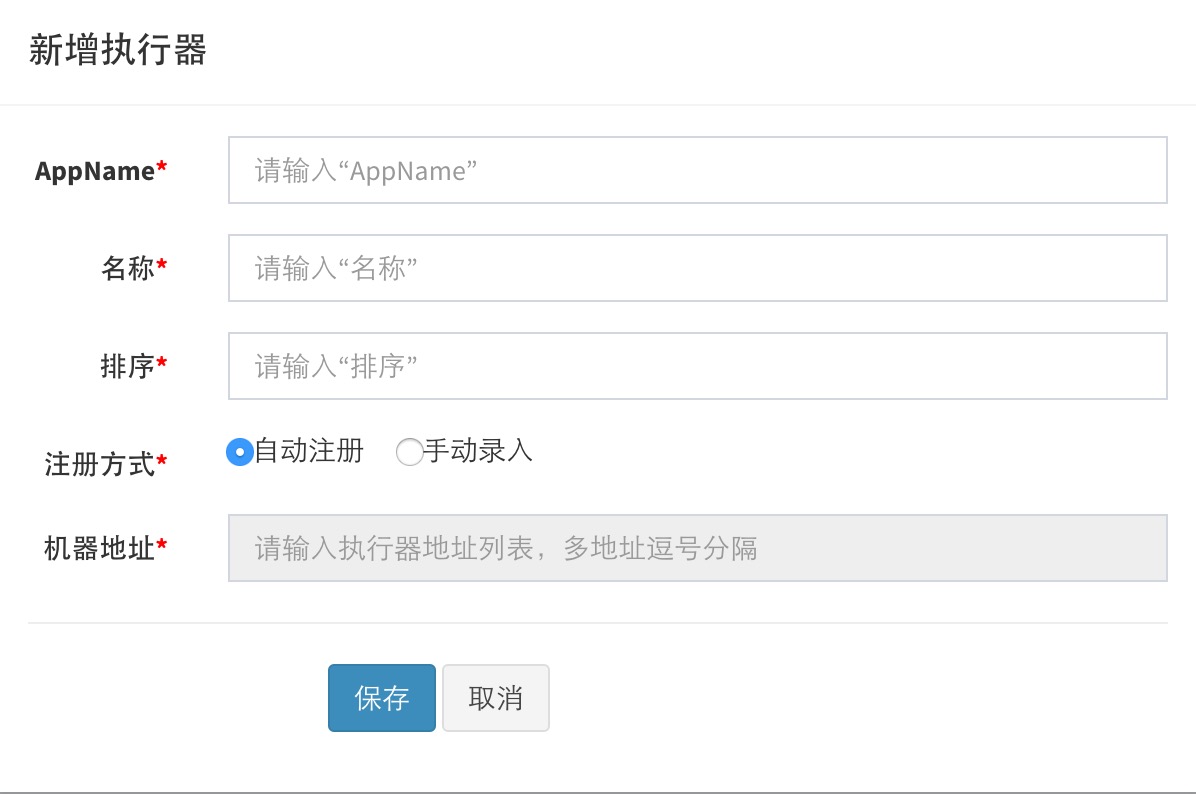
Description of executor attributes
AppName: the unique identity of the executor cluster,executor will registe automatically and periodically by appName so that it can be scheduled.
ŚźćÁßį: the name of ther executor,it is used to describe the executor.
śéíŚļŹ: the order of executor,it will be used in the place where need to select executor.
ś≥®ŚÜĆśĖĻŚľŹ:which way the schedule center used to acquire executor address through;
Ťá™Śä®ś≥®ŚÜĆ:executor will register automatically,through this schedule center can discover executor dynamically.
śČčŚä®ŚĹēŚÖ•:fill in executor address manually and it will be used by schedule center, multiple address separated by commas.
śúļŚô®ŚúįŚĚÄ:only effective when "ś≥®ŚÜĆśĖĻŚľŹ" is "śČčŚä®ŚĹēŚÖ•",support fill in executor address manually.
4.1 create new task
Go to task management list page,click ‚ÄúśĖįŚĘ욼ĽŚä°‚ÄĚ button on the upper right cornerÔľĆon the pop-up window‚ÄúśĖįŚĘ욼ĽŚä°‚ÄĚpage configure task property and save.learn more info please go and see "3,task details".
4.2 edit task
Go to task management list page and choose the task you want to edit ,click‚ÄĚÁľĖŤĺĎ‚ÄĚbutton on the right side of the task,on the pop-up window ‚ÄúÁľĖŤĺĎšĽĽŚä°‚ÄĚpage edit task property and save.
4.3 edit GLUE source code
Only fit to GLUE task.
choose the task you want to edit and click‚ÄĚ GLUE‚ÄĚbutton on the right side of the task, it will go to the Web IDE page of GLUE task,then you can edit task source code on this page.you can read "3.2 GLUEś®°ŚľŹ(Java)" for more info.
4.4 pause/recover task
You can pause or recover task but it just fit to follow up schedule trigger and won‚Äôt affect scheduled tasks,if you want to stop tasks which has been triggered,please go and see ‚Äú4.8 stop the running task‚ÄĚ
4.5 manually trigger
You can trigger a task manually by Click ‚ÄúśČߍ°Ć‚ÄĚbutton,it won‚Äôt affect original scheduling rules.
4.6 view schedule log
You can view task‚Äôs history schedule log by click ‚Äúśó•ŚŅó‚ÄĚ button,on the history schedule log list page you can view every time of task‚Äôs schedule result,execution result and so on,click ‚ÄúśČߍ°Ćśó•ŚŅó‚ÄĚ button can view the task‚Äôs full execute log.
ŤįÉŚļ¶śó∂ťóī:schedule center trigger time when schedule and send execution signal to executor;
ŤįÉŚļ¶ÁĽďśěú:schedule center trigger task‚Äôs result, 200 represent success,500 or other number stands for fail;
ŤįÉŚļ¶Ś§áś≥®:schedule center trigger task‚Äôs remark info;
śČߍ°ĆŚô®ŚúįŚĚÄ:the machine address where the task was executed;
ŤŅźŤ°Ćś®°ŚľŹ:run mode of triggered task,go and see "3,Task Details" for more info;
šĽĽŚä°ŚŹāśēį:the input params of the executed task;
śČߍ°Ćśó∂ťóī:the callback time task was done in the executor;
śČߍ°ĆÁĽďśěú:task‚Äôs execute result in the executor, 200 represent success,500 or other number stands for fail;
śČߍ°ĆŚ§áś≥®:task‚Äôs execute remark info in the executor;
śďćšĹú:
"śČߍ°Ćśó•ŚŅó"button:click this button you can view task‚Äôs execution detail log,go and see chapter 4.7 ‚Äúview execution log‚ÄĚ for more info;
"ÁĽąś≠ĘšĽĽŚä°"button:click this button you can stop the task‚Äôs execution thread on this executor,include bloked task instance which didn‚Äôt has started;
4.7 view execution log
Click the ‚ÄúśČߍ°Ćśó•ŚŅó‚ÄĚ button on the right side of the record,you can go to the execution log page,you can view the full execution log of the logic business code, shown as below:
4.8 stop running tasks
Just fit to running tasks,on the task log list page,click ‚ÄúÁĽąś≠ĘšĽĽŚä°‚ÄĚ button on the right side of the record, it will send stop command to the executor where the task was executed,finally the task was killed and the task instance execute queue of this task will be clear.
It is implemented by interrupt execute thread, it will trigger InterruptedException.so if JobHandler catch this execuption and handle this exception this function is unavailable.
So if you want stop the running task ,the JobHandler need to handle InterruptedException separately by throw this exception.the right logic is as shown below:
try{
// TODO
} catch (Exception e) {
if (e instanceof InterruptedException) {
throw e;
}
logger.warn("{}", e);
}
If JobHandler start child thread,child thread also must not catch InterruptedException,and it should throw exception.
4.9 delete execution log
On the task log list page, after you select executor and task, you can click"Śą†ťô§" button on the right side and it will pop-up "śó•ŚŅóśłÖÁźÜ" window,on the pop-up window you can choose different log delete policy,choose the policy you want to execute and click "Á°ģŚģö" button it will delele relative logs:

4.10 delete task
Click the delete button on the right side of the task,the task will be deteted.
5. Overall design
5.1 Source directory introduction
- /doc :documentation and material
- /db :db scripts
- /xxl-job-admin :schedule and admin center
- /xxl-job-core :common core Jar
¬† ¬†- /xxl-job-executor-samples :executorÔľĆDemo projectÔľąyou can develop on this demo project or adjust your own exist project to executor project)
5.2 configure database
XXL-JOB schedule module is implemented based on Quartz cluster,it‚Äôs ‚Äúdatabase‚ÄĚ is extended based on Quartz‚Äôs 11 mysql tables.
XXL-JOB custom Quartz table structure prefix(XXL_JOBQRTZ).
The added tables as shown below:
- XXL_JOB_QRTZ_TRIGGER_GROUP:executor basic table, maintain the info about the executor;
- XXL_JOB_QRTZ_TRIGGER_REGISTRY:executor register table, maintain addressed of online executors and schedule center machines.
- XXL_JOB_QRTZ_TRIGGER_INFO:schedule extend table,it is used to save XXL-JOB schedule extended info,such as task group,task name,machine address,executor,input params of task and alarm email and so on.
- XXL_JOB_QRTZ_TRIGGER_LOG:schedule log table,it is used to save XXL-JOB task’s histry schedule info,such as :schedule result,execution result,input param of scheduled task,scheduled machine and executor and so on.
- XXL_JOB_QRTZ_TRIGGER_LOGGLUE:schedule log table,it is used to save XXL-JOB task’s histry schedule info,such as :schedule result,execution result,input param of scheduled task,scheduled machine and executor and so on.
So XXL-JOB database total has 16 tables.
5.3 Architecture design
5.3.1 Design target
All schedule behavior has been abstracted into ‚Äúschedule center‚ÄĚ common platform , it dosen‚Äôt include business logic and just responsible for starting schedule requests.
All tasks was abstracted into separate JobHandler and was managed by executors, executor is responsible for receiving schedule request and execute the relative JobHandler business.
So schedule and task can be decoupled from each other, by the way it can improve the overall stability and scalability of the system.
5.3.2 System composition
- Schedule moduleÔľąschedule centerÔľČ: it is responsible for manage schedule info,send schedule request accord task configuration and it is not include an business code.schedule system decouple with the task, improve the overall stability and scalability of the system, at the same time schedule system performance is no longer limited to task modules. Support visualization, simple and dynamic management schedule information, include create,update,delete, GLUE develop and task alarm and so on, All of the above operations will take effect in real timeÔľĆsupport monitor schedule result and execution log and executor failover.
- Executor moduleÔľąExecutorÔľČ: it is responsible for receive schedule request and execute task logic,task module focuses on the execution of the task, Development and maintenance is simpler and more efficient. Receive execution request, end request and log request from schedule center.
5.3.3 Architecture diagram
5.4 Schedule module analysis
5.4.1 Disadvantage of quartz
Quartz is a good open source project and was often as the first choice for job schedule.Tasks was managed by api in quartz cluster so it can avoid some disadvantages of single quartz instance,but it also has some disadvantage as shown below:
- problem 1:it is not humane while operate task by call apill.
- problem 2:it is need to store business QuartzJobBean into database, System Invasion is quite serious.
- problem 3:schedule logic and couple with QuartzJobBean in the same project,it will lead a problem in case that if schedule tasks gradually increased and task logic gradually increased,under this situation the performance of the schedule system will be greatly limited by business.
XXL-JOB solve above problems of quartz.
5.4.2 RemoteHttpJobBean
Under Quartz develop,task logic often was maintained by QuartzJobBean, couple is very serious.in XXL-JOB"Schedule module" and "task module" are completely decoupled,all scheduled tasks in schedule module use the same QuartzJobBean called RemoteHttpJobBean.the params of the tasks was maintained in the extended tables,when trigger RemoteHttpJobBean,it will parse different params and start remote cal l and it wil call relative remote executor.
This call module is like RPC,RemoteHttpJobBean provide call proxy functionality,the executor is provided as remote service.
5.4.3 Schedule Center HAÔľąClusterÔľČ
It is based on Quartz clusterÔľĆdatabse use MysqlÔľõwhile QUARTZ task schedule is used in Clustered Distributed Concurrent Environment,all nodes will report task info and store into database.it will fetch trigger from database while execute task,if trigger name and execute time is the same only one node will execute the task.
# for cluster
org.quartz.jobStore.tablePrefix = XXL_JOB_QRTZ_
org.quartz.scheduler.instanceId: AUTO
org.quartz.jobStore.class: org.quartz.impl.jdbcjobstore.JobStoreTX
org.quartz.jobStore.isClustered: true
org.quartz.jobStore.clusterCheckinInterval: 1000
5.4.4 Schedule threadpool
Default threads in the threadpool is 10 so it can avoid task schedule delay because of single thread block.
org.quartz.threadPool.class: org.quartz.simpl.SimpleThreadPool
org.quartz.threadPool.threadCount: 10
org.quartz.threadPool.threadPriority: 5
org.quartz.threadPool.threadsInheritContextClassLoaderOfInitializingThread: true
business logic was executed on remote executor in XXL-JOB,schedule center just start one schedule request at every schedule time,executor will inqueue the request and response schedule center immediately. There is a huge difference from run business logic in quartz‚Äôs QuartzJobBean directlyÔľĆjust as Elephants and feathersÔľõ
the logic of task in XXL-JOB schedule center is very light and single job average run time alaways under 100ms,Ôľąmost is network time consumeÔľČ.so it can use limited threads to support a large mount of job run concurrently, 10 threads configured above can support at least 100 JOB normal execution.
5.4.5 @DisallowConcurrentExecution
This annotation is not used default by the schedule center of XXL-JOB schedule module, it use concurrent policy default,because RemoteHttpJobBean is common QuartzJobBean,so it greatly improve the capacity of schedule system and decrease the blocked chance of schedule module in the case of multi-threaded schedule.
Every schedule module was scheduled and executed parallel in XXL-JOB,but tasks in executor is executed serially and support stop task.
5.4.6 misfire
The handle policy when miss the job‚Äôs trigger time. he reason may be:restart service,schedule thread was blocked by QuartzJobBean, threads was exhausted,some task enable @DisallowConcurrentExecutionÔľĆthe last schedule was blocked and next schedule was missed.
The default value of misfire in quartz.properties as shown below, unit in milliseconds:
org.quartz.jobStore.misfireThreshold: 60000
Misfire rule:
withMisfireHandlingInstructionDoNothing:does not trigger execute immediately and wait for next time schedule.
withMisfireHandlingInstructionIgnoreMisfires:execute immediately at the first frequency of the missed time.
withMisfireHandlingInstructionFireAndProceed:trigger task execution immediately at the frequency of the current time.
XXL-JOB’s default misfire rule:withMisfireHandlingInstructionDoNothing
CronScheduleBuilder cronScheduleBuilder = CronScheduleBuilder.cronSchedule(jobInfo.getJobCron()).withMisfireHandlingInstructionDoNothing();
CronTrigger cronTrigger = TriggerBuilder.newTrigger().withIdentity(triggerKey).withSchedule(cronScheduleBuilder).build();
5.4.7 log callback service
When schedule center of the schedule module was deployed as web service, on one side it play as schedule center, on the other side it also provide api service for executor.
The source code location of schedule center‚Äôs ‚Äúlog callback api service‚ÄĚ as shown below:
xxl-job-admin#com.xxl.job.admin.controller.JobApiController.callback
Executor will execute task when it receive task execute request.it will notify the task execute result to schedule center when the task is done.
5.4.8 task HAÔľąFailoverÔľČ
If executor project was deployed as cluster schedule center will known all online executor nodes,such as:‚Äú127.0.0.1:9997, 127.0.0.1:9998, 127.0.0.1:9999‚ÄĚ.
When "Ť∑ĮÁĒĪÁ≠ĖÁē•" select "śēÖťöúŤĹ¨Á߼(FAILOVER)",it will send heart beat check request in order while schedule center start schedule request. The first alive checked executor node will be selected and send schedule request to it.
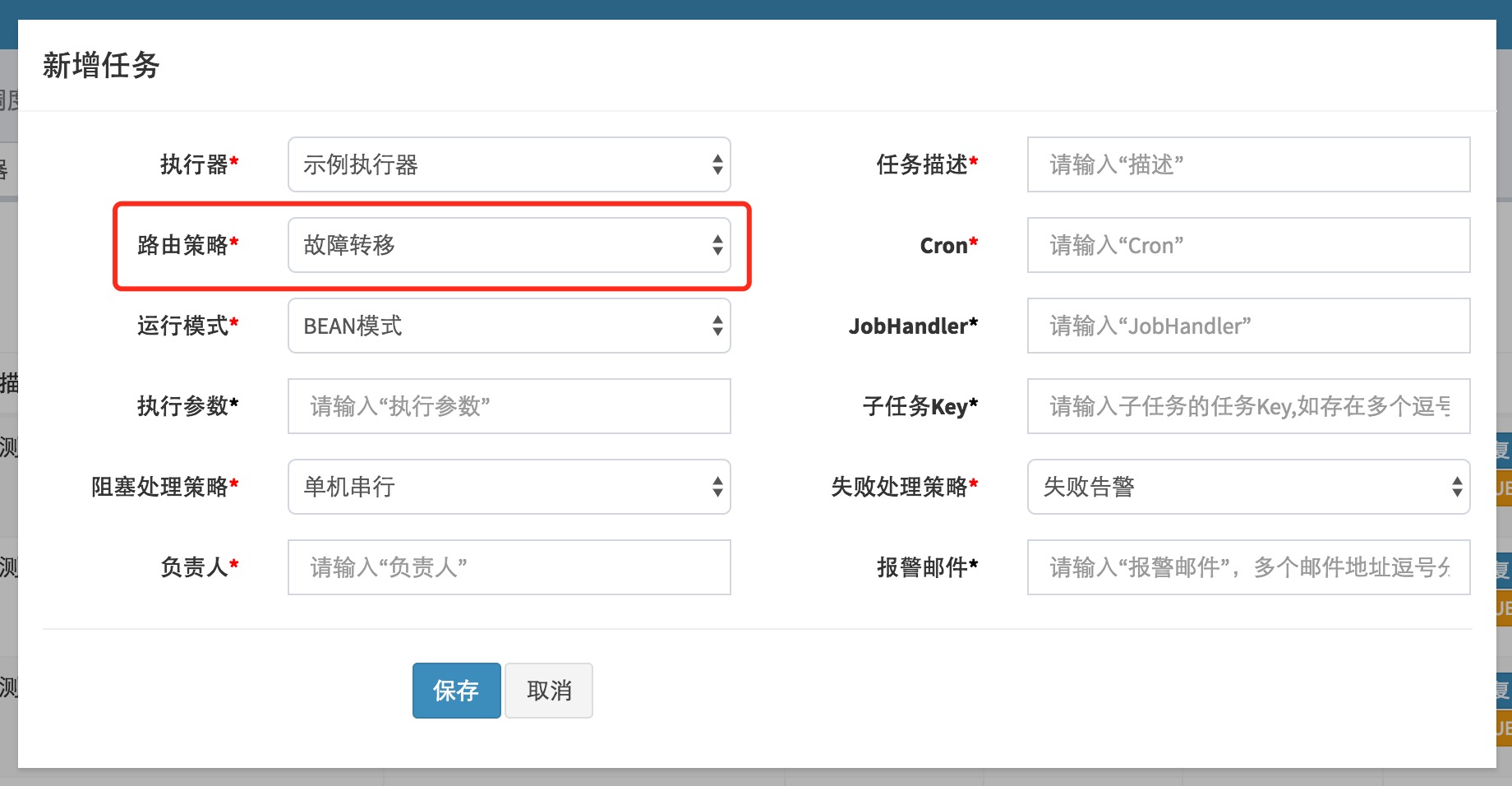
‚ÄúŤįÉŚļ¶Ś§áś≥®‚ÄĚ can be viewed on the monitor page when schedule success. As shown below:
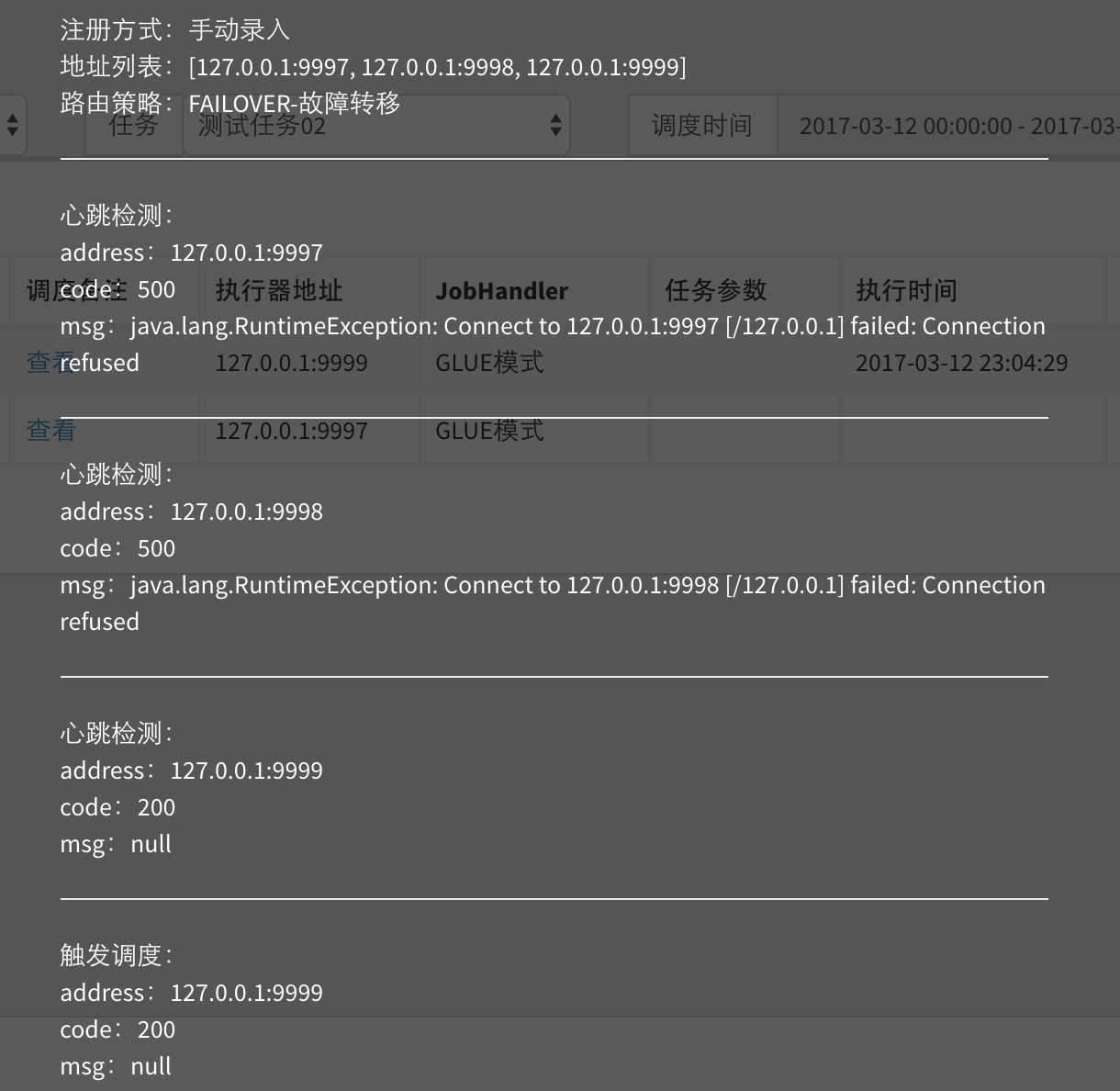
‚ÄúŤįÉŚļ¶Ś§áś≥®‚ÄĚ will display local schedule route path„ÄĀexecutor‚Äôs "ś≥®ŚÜĆśĖĻŚľŹ"„ÄĀ"ŚúįŚĚÄŚąóŤ°®" and task‚Äôs "Ť∑ĮÁĒĪÁ≠ĖÁē•"„ÄāUnder "śēÖťöúŤĹ¨Á߼(FAILOVER)" policy, schedule center take first address to do heartbeat detection, heat beat fail will automatically skip, the second address heart beat fail‚Ķ‚Ķ until the third address ‚Äú127.0.0.1:9999‚ÄĚ heart beat success, it was selected as target executor, then send schedule request to target executor, now the schedule process is end wait for the executor‚Äôs callback execution result.
5.4.9 schedule log
Every time when task was scheduled in the schedule center it will record a task log, the task log include three part as shown below:
- šĽĽŚä°šŅ°śĀĮ:include executor address„ÄĀJobHandler and executor paramsÔľĆaccord these parameters it can locate specific machine and task code that the task will be executed.
- ŤįÉŚļ¶šŅ°śĀĮ:include schedule time„ÄĀschedule result and schedule log and so onÔľĆaccord these parameters you can understand some task schedule info of schedule center.
- śČߍ°ĆšŅ°śĀĮ:include execute time„ÄĀexecute result and execute log and so on, accord these parameters you can understand the task execution info in the executor.
Schedule log stands fo single task schedule, attribute description is as follows:
- śČߍ°ĆŚô®ŚúįŚĚÄ:machine addresses on which task will be executed.
- JobHandler:JobHandler name of task under Bean module.
- šĽĽŚä°ŚŹāśēį:the input parameters of task
- ŤįÉŚļ¶śó∂ťóī:the schedule time started by schedule center.
- ŤįÉŚļ¶ÁĽďśěú:schedule result of schedule center,SUCCESS or FAIL.
- ŤįÉŚļ¶Ś§áś≥®:remark info of task scheduled by schedule center, such as address heart beat log.
- śČߍ°Ćśó∂ťóī:the callback time when the task is done in the executor.
- śČߍ°ĆÁĽďśěú:task execute result in the executor,SUCCESS or FAIL.
- śČߍ°ĆŚ§áś≥®:task execute remark info in the executor,such as exception log.
- śČߍ°Ćśó•ŚŅó:full execution log of the business code during execution of the task,go and see ‚Äú4.7 view execution log‚ÄĚ.
5.4.10 Task dependency
principle:every task has a task key in XXL-JOB, every task can configure property ‚Äúchild task Key‚ÄĚ,it can match task dependency relationship through task key.
When parent task end execute and success, it will match child task dependency accord child task key, it will trigger child task execute once if it matched child task.
On the task log page ,you can see matched child task and triggered child task‚Äôs log info when you ‚Äúśü•Áúč‚ÄĚbutton of ‚ÄúśČߍ°ĆŚ§áś≥®‚ÄĚ,otherwise the child task didin‚Äôt execute, as shown beleow:
5.5 Task "run mode" analysis
5.5.1 "Beanś®°ŚľŹ" task
Development steps:go and see "chapter 3" . principle: every Bean mode task is a Spring Bean instance and it is maintained in executor project‚Äôs Spring container. task class nedd to add ‚Äú@JobHander(value="name")‚ÄĚ annotation, because executor identify task bean instance in spring container through annotation. Task class nedd to implements interface IJobHandler, task logic code in method execute(), the task logic in execute() method will be executed when executor received a schedule request from schedule center.
5.5.2 "GLUEś®°ŚľŹ(Java)" task
Development steps:go and see "chapter 3" . Principle : every "GLUEś®°ŚľŹ(Java)" task code is a class implemets interface IJobHandler, when executor received schedule request from schedule center these code will be loaded by Groovy classloader and instantiate into a Java object and inject spring bean service declared in this code at the same timeÔľąplease confirm service and class reference in Glue code exist in executor projectÔľČ, then call the object‚Äôs execute() method and execute task logic.
5.5.3 GLUEś®°ŚľŹ(Shell) + GLUEś®°ŚľŹ(Python)
Development steps:go and see "chapter 3" . principle:the source code of script task is maintained in schedule center and script logic will be executed in executor. when script task was triggered, executor will load script source code and generate a script file on the machine where executor was deployed, the script will be called by java code, the script output log will be written to the task log file in real time so that we can monitor script execution in real time through schedule center, the return code 0 stands for success other for fail.
All supported types of scripts as shown beloes:
- shell script:shell script task will be enabled when select "GLUEś®°ŚľŹ(Shell)"as task run mode.
- python script: python script task will be enabled when select " GLUEś®°ŚľŹ(Python)"as task run mode.
5.5.4 executor
Executor is actually an embedded Jetty server with default port 9999, as shown belowÔľąparameter:xxl.job.executor.portÔľČ.
Executor will identify Bean mode task in spring container through @JobHander When project start, it will be managed use the value of annotation as key.
When executor received schedule request from schedule center, if task type is ‚ÄúBeanś®°ŚľŹ‚ÄĚ it will match bean mode task in Spring container and call it‚Äôs execute() method and execute task logic. if task type is ‚ÄúGLUEś®°ŚľŹ‚ÄĚ, it will load Glue code, instantiate a Java object and inject other spring serviceÔľąnotice: the spring service injected in Glue code must exist in the same executor projectÔľČ, then call execute() method and execute task logic.
5.5.5 task log
XXL-JOB will generate a log file for every schedule request, the log info will be recorded by XxlJobLogger.log() method, the log file will be loaded when view log info through schedule center.
(history version is implemented by overriding LOG4J’s Appender so it exists dependency restrictions, The way has been discraded in the new version)
The location of log file can be specified in executor configuration file, default pattern is : /data/applogs/xxl-job/jobhandler/formatted date/primary key for database scheduling log records.log‚ÄĚ.
When start child thread in JobHandler, child thread will print log in parent JobHandler thread’s execute log in order to trace execute log.
5.6 Communication module analysis
5.6.1 A complete task schedule communication process
- 1,schedule center send http request to executor, and the service in executor in fact is a jetty server with default port 9999.
- 2,executor execute task logic.
- 3,executor http callback with schedule center for schedule result, the service in schedule center used to receive callback request from executor is a set of api opended to executor.
5.6.2 Encrypt Communication data
When scheduler center send request to executor, it will use RequestModel and ResponseModel object to encapsulate schedule request parameters and response data, these two object will be serialized before communication, data protocol and time stamp will be checked so that achieve data encryption target.
5.7 task register and task auto discover
Task executor machine property has been canceled from v1.5, instead of task register and auto discovery, get remote machine address dynamic.
AppName: unique identify of executor cluster, executor is minimal unite of task register, every task recognize machine addresses under the executor on which it was binded.
Beat: heartbeat cycle of task register, default is 15s, and the time executor usedto register is twice the time, the time used to auto task discover is twice the beat time, the invalid time of register is twice the Beat time.
registry table: see XXL_JOB_QRTZ_TRIGGER_REGISTRY table, it will maintain a register record periodically while task register, such as the bind relationship between machine address and AppName, so that schedule center can recognize machine list by AppName dynamicly.
To ensure system lightweight and reduce learning costs, it did not use Zookeeper as register center, Use DB as register center to do task registration.
5.8 task execute result
Since v1.6.2, the task execute result is recognized through ReturnT of IJobHandler, it executes success when return value meets the condition "ReturnT.code == ReturnT.SUCCESS_CODE" , or it executes fail, and it can callback error message info to schedule center through ReturnT.msg, so it can control task execute results in the task logic.
5.9 slice broadcat & dynamic slice
When ‚ÄúŚąÜÁČáŚĻŅśí≠‚ÄĚ is selected as route policy in executor cluster, one task schedule will broadcast all executor node in cluster to trigger task execute in every executor, pass slice parameter at the same time, so we can develop slice task by slice parameters.
"ŚąÜÁČáŚĻŅśí≠" break the task by the dimensions of executor, support dynamic extend executor cluster so that it can add slice number dynamically to do business process, In case of large amount of data process can significantly improve task processing capacity and speed.
The develop process of "ŚąÜÁČáŚĻŅśí≠" is the same as general task, The difference is that you can get slice parametersÔľĆcode as shown belowÔľągo and see ShardingJobHandler in execuotr example ):
ShardingUtil.ShardingVO shardingVO = ShardingUtil.getShardingVo();
This slice parameter object has two properties:
index:the current slice number(start with 0)ÔľĆstands for the number of current executor in the executor cluster.
total:total slice number,stands for total slices in the executor cluster.
This feature applies to scenes as shown below:
- 1„ÄĀslice task scene:when 10 executor to handle 10w records, 1w records need to be handled per machine, time-consuming 10 times lowerÔľõ
- 2„ÄĀBroadcast task scene:broadcast all cluster nodes to execute shell script„ÄĀbroadcast all cluster nodes to update cache.
5.10 AccessToken
To improve system security it is need to check security between schedule center and executor, just allow communication between them when AccessToken of each other matched.
The AccessToken of scheduler center and executor can be configured by xxl.job.accessToken.
There are only two settings when communication between scheduler center and executor just:
- one:do not configure AccessToken on both, close security check.
- two:configure the same AccessToken on both;
5.11 Dispatching center API services
The scheduling center provides API services for executors and business parties to choose to use, and the currently available API services are available.
1. Job result callback service;
2. Executor registration service;
3. Executor registration remove services;
4. Triggers a single execution service, and support the task to be triggered according to the business event;
The scheduling center API service location: com.xxl.job.core.biz.AdminBiz.java
The scheduling center API service requests reference codeÔľöcom.xxl.job.dao.impl.AdminBizTest.java
6 Version update log
6.1 version V1.1.xÔľĆNew features [2015-12-05]
„Äźsince V1.1.xÔľĆXXL-JOB was used by company hiring meÔľĆalias Ferrari inner companyÔľĆthe latest version is recommended for new project„ÄĎ
- 1„ÄĀsimple:support CRUD operation through Web page, simple and one minute to get started;
- 2„ÄĀdynamic:support dynamic update task status,pause/recover task and effective in real time;
- 3„ÄĀservice HA:task info stored in mysql, Job service support cluster to make sure service HA;
- 4„ÄĀtask HA:when some Job services hangs up, tasks will be assigned to some other alive machines, if all nodes of the cluster hangs up, it will compensate for the execution of lost task when restart;
- 5„ÄĀone task instance will only be executed on one executor;
- 6„ÄĀtask is executed serially;
- 7„ÄĀsupport for custom parameters;
- 8„ÄĀSupport pause task execution remotely .
6.2 version V1.2.xÔľĆNew features [2016-01-17]
- 1„ÄĀsupport task group;
- 2„ÄĀsuport local task, remote task;
- 3„ÄĀsupport two types underlying communication ,Servlet or JETTY;
- 4„ÄĀsupport task log;
5„ÄĀsupport serially executionÔľĆparallel execution;
Description:system architecture of V1.2 divided by function as shown below:
- schedule moduleÔľąschedule centerÔľČ:Responsible for managing schedule informationÔľĆsend schedule request according to the schedule configuration; - execute moduleÔľąexecutorÔľČ:Responsible for receiving schedule request and execute task logic; - communication module:Responsible for the communication between the schedule module and execute module;advantage:
- Decouple:execute module supply task api, schedule module maintains schedule information, The business is independent of each other; - High scalability; - stability;
6.3 version V1.3.0ÔľĆNew features [2016-05-19]
- 1„ÄĀdiscard local task module, remote task was recommended, easy to decouple system, the JobHander of task was called executor.
- 2„ÄĀdicard underlying communication type servlet, JETTY was recommended, schedule and callback bidirectional communication, rebuild the communication logic;
- 3„ÄĀUI interactive optimization:optimize left menu expansion and menu item selected status , task list opens the table with compression optimization;
4„ÄĀ„Äźimportant„ÄĎexecutor is subdivided into two develop mode:BEAN„ÄĀGLUE:
Introduction to the executor mode:
- BEAN mode executor:every executor is a Spring Bean instanceÔľĆit was recognized and scheduled by XXL-JOB through @JobHander annotation; -GLUE mode executor:every executor corresponds to a piece of codeÔľĆedited and maintained online by Web, Dynamic compile and takes effect in real time, executor is responsible for loading GLUE code and executing;
6.4 version V1.3.1ÔľĆNew features [2016-05-23]
- 1„ÄĀUpdate project directory structure:
- /xxl-job-admin -------------------- „Äźschedule center„ÄĎ:Responsible for managing schedule informationÔľĆsend schedule request according to schedule configuration;
- /xxl-job-core ----------------------- Public core dependence
- /xxl-job-executor-example ------ „Äźexecutor„ÄĎ:Responsible for receiving scheduling request and execute task logic;
- /db ---------------------------------- create table script
- /doc --------------------------------- user manual
- 2„ÄĀUpgrade the user manual under the new directory structure;
- 3„ÄĀOptimize some interactions and UI;
6.5 version V1.3.2ÔľĆNew features [2016-05-28]
- 1„ÄĀSchedule logic for transactional handle;
- 2„ÄĀexecutor asynchronous callback execution log;
- 3„ÄĀ„Äźimportant„ÄĎbased on HA support of schedule centerÔľĆextend executor‚Äôs Failover supportÔľĆSupport configure multiple execution addresses;
6.6 version V1.4.0 New features [2016-07-24]
- 1„ÄĀTask dependency: it is implemented by trigger event, it will automatically trigger a child task schedule after Task execute success and callback, multiple child tasks are separated by commas;
- 2„ÄĀexecutor source code has been reconstructed, optimize underlying db script;
- 3„ÄĀoptimize task thread group logic of executor, before it is group by executor‚Äôs JobHandler so when multiple task reuse Jobhanlder will cause block with each other. Now it is grouped by task of schedule center so tasks are isolated from task execution.
- 4„ÄĀoptimize communication scheme between executor and schedule center, a simple RPC protocol was implemented through Hex + HC, optimize the maintenance and analysis process of communication parameters.
- 5„ÄĀschedule center, create/edit task, page attribute adjustment:
- 5.1„ÄĀthe property JobName was removed from task add/edit page and it is changed to automatically generate by system: this field before is used to identify a task in schedule center and did not use in other scenes, so remove it to simplify the task creation;
- 5.2„ÄĀadjust "GLUEś®°ŚľŹ" property in task add/edit page to near JobHandler input box;
- 5.3„ÄĀ"śä•Ť≠¶ťėąŚÄľ" property was removed from task add/edit page;
- 5.4„ÄĀ"Ś≠źšĽĽŚä°Key" property was removed from task add/edit page, the key of task can be acquired from task list page, child task will be triggered by child task key when main task execute success.
- 6„ÄĀbug fix:
- 6.1„ÄĀoptimize jetty executor shutdown, solve one problem may cause jetty could not shutdown.
- 6.2„ÄĀoptimize callback of executor task queue when task execute finish. Solve a problem which may cause task could not callback.
- 6.3„ÄĀOptimize Page List Parameters of Schedule Center, solve one problem which may be caused by post length limit of server.
- 6.4„ÄĀoptmize executor Jobhandler annotation, solve a problem that container could not load the JobHandler caused by the transaction proxy.
- 6.5„ÄĀoptimize remote schedule, disable retry policy, solve a problem may caused repeat call;
Tips: V1.3.x release has been published , enter the maintenance phase, branch address is V1.3 .New features will be updated continuously in the master branch.
6.7 version V1.4.1 New features [2016-09-06]
1„ÄĀproject successfully pushed to maven central warehouse, Central warehouse address and dependency as shown below:
<!-- http://repo1.maven.org/maven2/com/xuxueli/xxl-job-core/ --> <dependency> <groupId>com.xuxueli</groupId> <artifactId>xxl-job-core</artifactId> <version>${śúÄśĖįÁ®≥ŚģöÁČą}</version> </dependency>2„ÄĀTo adapt to the rules of central warehouse, groupId has been changed from com.xxl to com.xuxueli.
3„ÄĀto resolve the problem that sub-modules can not be compiled separately, system version is not maintained in the project root pom, each sub-module is configured separately for version configuration;
4„ÄĀoptimize data byte length statistics rule of RPC communication it may reduce 50% of data traffic;
5„ÄĀIJobHandler cancel task return value, before the execution status is judged by the return value, now it instead of task was executed successfully by default only when exception was caught the task execution was judged failed.
6„ÄĀoptimize system public pop-up box as a plugin;
7„ÄĀoptimize table structure and the table name now is upper case;
8„ÄĀmodify ContentType of JSON response from exception handler of schedule center to fix the bug that it is could not recognized by browser.
6.8 version V1.4.2 New features [2016-09-29]
- 1„ÄĀpush V1.4.2 to maven central warehouse, main version V1.4 enter maintenance phase;
- 2„ÄĀfix problem task list offset when add task;
- 3„ÄĀfix a style disorder problem that caused by bootstrap does not support the modal frame overlap , the problem occurs when the task is edited;
- 4„ÄĀoptimize schedule status when schedule timeout and Handler could not matched;
- 5„ÄĀthe task could not stop problem caused by catch exception has given solution;
6.9 version V1.5.0 New features [2016-11-13]
- 1„ÄĀtask register: executor registers the task automatically, schedule center will automatically discover the registered task and trigger execution.
- 2„ÄĀadd parameter AppName for executor: AppName is the unique identifier of each executor cluster, register periodically and automatically with AppName.
- 3„ÄĀadd column executor management in schedule center : manage online executors, automatically discover registered executors via the property AppName„ÄāOnly managed executors are allowed to be used;
- 4„ÄĀchange Task group attribute to executor : each task needs to be bound to the specified exector, schedule address is obtained by binded executor;
- 5„ÄĀdiscard property task machine: by the way of binding task with executor, automatically discovers registered remote executor address and triggers schedule request.
- 6„ÄĀadd DBGlueLoader in public dependency, it implement GLUE source code calssloader based on native jdbc, Reduce third party reliance (mybatis,spring-orm etc); simplify and optimize executor configuration (for GLUE task), Reduce the difficulty of getting started;
- 7„ÄĀadjust table structure, reconstruct the project;
- 8„ÄĀschedule center automatically registered and found, failover: schedule center periodically registered automatically, task callback can recognize all online schedule center addresses, task callback support failover so that it can avoid single point of risk.
6.10 version V1.5.1 New features [2016-11-13]
- 1„ÄĀReconstruct the underlying code and optimize logic, clean POM and Clean Code;
- 2„ÄĀServlet/JSP Spec selected 3.0/2.2;
- 3„ÄĀSpring updated to 3.2.17.RELEASE version;
- 4„ÄĀJetty updated to version 8.2.0.v20160908;
- 5„ÄĀhas push V1.5.0 and V1.5.1 to maven central warehouse;
6.10 version V1.5.2 New features [2017-02-28]
- 1„ÄĀoptimize IP tools class which used to gets IP addressÔľĆIP static cache;
- 2„ÄĀboth executor and schedule center support customize registered IP address;Solve problem when machine has multiple network card and get the wrong card;
- 3„ÄĀsolve the problem that it will generate multiple log files when executed across days;
- 4„ÄĀthe non-sensitive log level is adjusted to debug;
- 5„ÄĀUpgrade the database connection pool to c3p0;
- 6„ÄĀoptimize log4j property of executorÔľĆremove invalid attribute;
- 7„ÄĀreconstruct underlying code and optimize logic and Clean Code;
- 8„ÄĀoptimize Dependency Injection Logic of GLUE, support injected as alias;
6.11 version V1.6.0 New features [2017-03-13]
- 1„ÄĀupgrade communication schemeÔľĆthe HEX communication model is adjusted to the B-RPC model based on HTTP;
- 2„ÄĀexecutor supports set execution address list manuallyÔľĆprovide switch to use automatically registered address or manually set address;
- 3„ÄĀexecutor route rules:Á¨¨šłÄšł™„ÄĀśúÄŚźéšłÄšł™„ÄĀŤĹģŤĮĘ„ÄĀťöŹśúļ„ÄĀšłÄŤáīśÄßHASH„ÄĀśúÄšłćÁĽŹŚłłšĹŅÁĒ®„ÄĀśúÄŤŅĎśúÄšĻÖśú™šĹŅÁĒ®„ÄĀśēÖťöúŤĹ¨Á߼;
- 4„ÄĀunified thread model and thread destruction scheme (by the way of listener or stop() methodÔľĆDestroy the thread when container is destroyed;Daemon is sometimes not ideal);
- 5„ÄĀunified system configuration dataÔľĆUnified managed by configuration files;
- 6„ÄĀCleanCodeÔľĆClean up invalid historical parameters;
- 7„ÄĀextend data structure and adjust related table structure;
- 8„ÄĀnew created task defaults to a non-running state;
- 9„ÄĀoptimize update logic of GLUE mode task instance , The original update is based on the timeout value and now is updated according to the version numberÔľĆversion number plus one while source changed;
6.12 version V1.6.1 New features [2017-03-25]
- 1„ÄĀRolling log;
- 2„ÄĀreconstruct WebIDE interactive;
- 3„ÄĀenhanced communication checkÔľĆfilter unnormal requests effectively;
- 4„ÄĀenhanced permission checkÔľĆUsing dynamic login TOKENÔľąrecommend instead of internal SSOÔľČ;
- 5„ÄĀoptimize database configurationÔľĆsolve garbled problem;
6.13 version V1.6.2 New features [2017-04-25]
- 1„ÄĀexecution report:support view run time data in real time, such as task number, total schedule number, executor number etc., include schedule report , such as scheduled distribution graph on date, scheduled success distribution graph etc;
- 2„ÄĀJobHandler support set return value for tasks, it is easy to control task execute result in task logic;
- 3„ÄĀthe problem could not view exception info when resource path include space or chinese word casused resource file could not be loaded;
- 4„ÄĀoptimize route policy:fix problems that Loop and LFU routing policy counters are no limit and first route is focused on the first machine;
6.14 version V1.7.0 New features [2017-05-02]
- 1„ÄĀscript task:support develop and run script task by GLUE, include script type such as Shell„ÄĀPython and Groovy;
- 2„ÄĀadd spring-boot type executor example project;
- 3„ÄĀupgrade jetty to version 9.2;
- 4„ÄĀtask execute log remove log4j dependency, instead of self-realizationÔľĆThus eliminate the dependency on the log component;
- 5„ÄĀexecutor remove GlueLoader dependencyÔľĆinstead of push modeÔľĆthus GLUE source code load no longer rely on JDBC;
- 6„ÄĀget the project name when login and redirect, solve 404 problem when it is not deployed by the directory;
6.15 version V1.7.1 New features [2017-05-08]
- 1„ÄĀunified write and read code of execute log as UTF-8ÔľĆsolve log garbled problem under windows environment;
- 2„ÄĀcommunication timeout period is limited to 10sÔľĆTo avoid schedule thread is occupied under abnormal situation;
- 3„ÄĀadjust executor , server stat, destroy and register logic;
- 4„ÄĀoptimize Jetty Server shutdown logic, repair port occupation caused by executor could not be closed normally and frequent printe c3p0 log probleam;
- 5„ÄĀstart child thread in JobHandlerÔľĆsupport child thread print execute log and view by Rolling;
- 6„ÄĀtask log cleanup;
- 7„ÄĀpop-up component is replaced by layer;
- 8„ÄĀupgrade quartz to version 2.3.0;
6.16 version V1.7.2 New features [2017-05-17]
- 1„ÄĀblock handle policy:the policy when schedule is too frequently and the executor it too late to handle, include multiple strategies:single machine serially executeÔľądefaultԾȄÄĀdiscard subsequent schedule„ÄĀoverride before schedule;
- 2„ÄĀfail handle policy:handle policy when scheduled fail, include :failure alarmÔľądefaultԾȄÄĀfailed to retry;
- 3„ÄĀThe communication timeout is adjusted to 180s;
- 4„ÄĀexecutor and database are completely decoupledÔľĆBut the executor needs to configure schedule center cluster address„Äāschedule center provides APIs for executor callbacks and heartbeat registration servicesÔľĆcancel jetty inner schedule center, heartbeat cycle is adjusted to 30sÔľĆheartbeat failure is triple heartbeat;
- 5„ÄĀfix executor parameters lost bug when edit;
- 6„ÄĀadd task test Demo to make task logic test easier;
6.17 version V1.8.0 New features [2017-07-17]
- 1„ÄĀoptimize update logic of task CronÔľĆinstead of rescheduleJobÔľĆat the same time preventing set cron repeatedly;
- 2„ÄĀoptimize API callback service failed status codeÔľĆfacilitate troubleshooting;
- 3„ÄĀXxlJobLogger support multi-parameter;
- 4„ÄĀroute policy add "ŚŅôÁĘƍŨÁ߼" mode:Perform idle detection in sequenceÔľĆThe first idle test successfully machine is selected as the target executor and trigger schedule;
- 5„ÄĀreconstruct route policy code;
- 6„ÄĀfix executor repeat registration problem;
- 7„ÄĀTask thread will be destroyed after 30 times idle turn, reduce the inefficient thread consumption of low frequency tasks;
- 8„ÄĀExecutor task execution result batch callback so that reduce callback frequency to improve actuator performance;
- 9„ÄĀcancle XML configuration of springboot executor projectÔľĆinstead of class configuration;
- 10„ÄĀsupports filter execute log based on running status;
- 11„ÄĀoptimize scheduling Center Task Registration Detection Logic;
6.18 version V1.8.1 New features [2017-07-30]
- 1„ÄĀslice broadcast task:When slice broadcast is selected as route policy in executor cluster, one task schedule will broadcast all executor node in cluster to trigger task execute in every executor, pass slice parameter at the same time, so we can develop slice task by slice parameters;
- 2„ÄĀdynamic slice: break the task by the dimensions of executor, support dynamic extend executor cluster so that it can add slice number dynamically to do business process, In case of large amount of data process can significantly improve task processing capacity and speed;
- 3„ÄĀexecutor JobHandler disables name conflicts;
- 4„ÄĀexecutor cluster address list for natural sorting;
- 5„ÄĀadd test cases and optimize DAO layer code for Scheduling center;
- 6„ÄĀschedule Center API service change to self-study RPC framework to u nify communication model;
- 7„ÄĀadd schedule center API service test Demo, convenient in dispatch center API extension and testing;
- 8„ÄĀTask list page interaction optimizationÔľĆThe task list is automatically refreshed when the executor group is replacedÔľĆcreate new job defaults to locate current executor position;
- 9„ÄĀaccess Token:To improve system securityÔľĆit is used for safety check between schedule center and executor, communication allowed just when Both Access Token matched;
- 10„ÄĀupgrade springboot version to 1.5.6.RELEASE of executor;
- 11„ÄĀunify maven version dependency management;
6.19 version V1.8.2 New features[Coding]
- 1,support configuring the HTTPS for executor callback URL;
- 2,Standardize project directory for extend multi executors;
- 3,add JFinal type executor sample project;
TODO LIST
- 1,Task privilege management:control privilege on executor, check privilege on core operations;
- 2,Task slice routing:using consistent Hash algorithm to calculate slice order as stable as possible, even if there is fluctuation in the registration machine will not cause large fluctuations in the order of slice. Currently using IP natural sorting can meet the demandÔľĆto be determined;
- 3,Failure retry optimization:The current failure to retry logic is execute the request logic once again after the scheduled request fails„ÄāThe optimization point is retry for both scheduling and execution failures, retry a full schedule when retryingÔľĆThis may lead schedule failure to an infinite loopÔľĆto be determined;
- 4,write file when callback failedÔľĆread the log when viewing the logÔľĆcallback confirm after rebooting;
- 5,Task dependencyÔľĆflow chartÔľĆchild task + aggregation taskÔľĆlog of each node;
- 6,Scheduled task priority;
- 7,Remove quartz dependencies and rewrite scheduld module:insert the next execution record into delayqueue when add or resume task, schedule center cluster compete distributed lockÔľĆsuccessful nodes bulk load expired delayqueue data and batch execution;
- 8,springboot and docker imageÔľĆand push docker image to the central warehouseÔľĆfurther realize product out of the box;
- 9,globalization:schedule center interface and Official documentsÔľĆadd English version;
- 10,executor removal:notify schedule center and remove the corresponding execute node when executor is destroyed, improve the timeliness of executor state recognized;
7. Other
7.1 Contributing
Contributions are welcome! Open a pull request to fix a bug, or open an Issue to discuss a new feature or change.
7.2 used recordsÔľąrecord just for spreadÔľĆProduct is open source and free of chargeÔľČ
Record for spread product and product is free and open source. Welcome to check inon github.
7.3 Copyright and License
This product is open source and free, and will continue to provide free community technical support. Individual or enterprise users are free to access and use.
- Licensed under the GNU General Public License (GPL) v3.
- Copyright (c) 2015-present, xuxueli.
Donate
No matter how much the amount is enough to express your thought, thank you very much ÔľöÔľČ


